Hospitality Provision in Travel & Tourism Sector: A Comprehensive Analysis
VerifiedAdded on 2024/05/21
|19
|5967
|265
AI Summary
This report delves into the intricate relationship between hospitality and the broader travel and tourism industry. It examines the interrelationships between these sectors, analyzes the implications of integration on the hospitality industry, and explores the impact of mergers and acquisitions on major hospitality brands. Furthermore, the report presents a comprehensive business development plan for a mid-level hotel, outlining its operational requirements, organizational structure, and human resource allocation. This analysis provides valuable insights into the dynamics of the hospitality sector and its crucial role in the global tourism landscape.
Contribute Materials
Your contribution can guide someone’s learning journey. Share your
documents today.
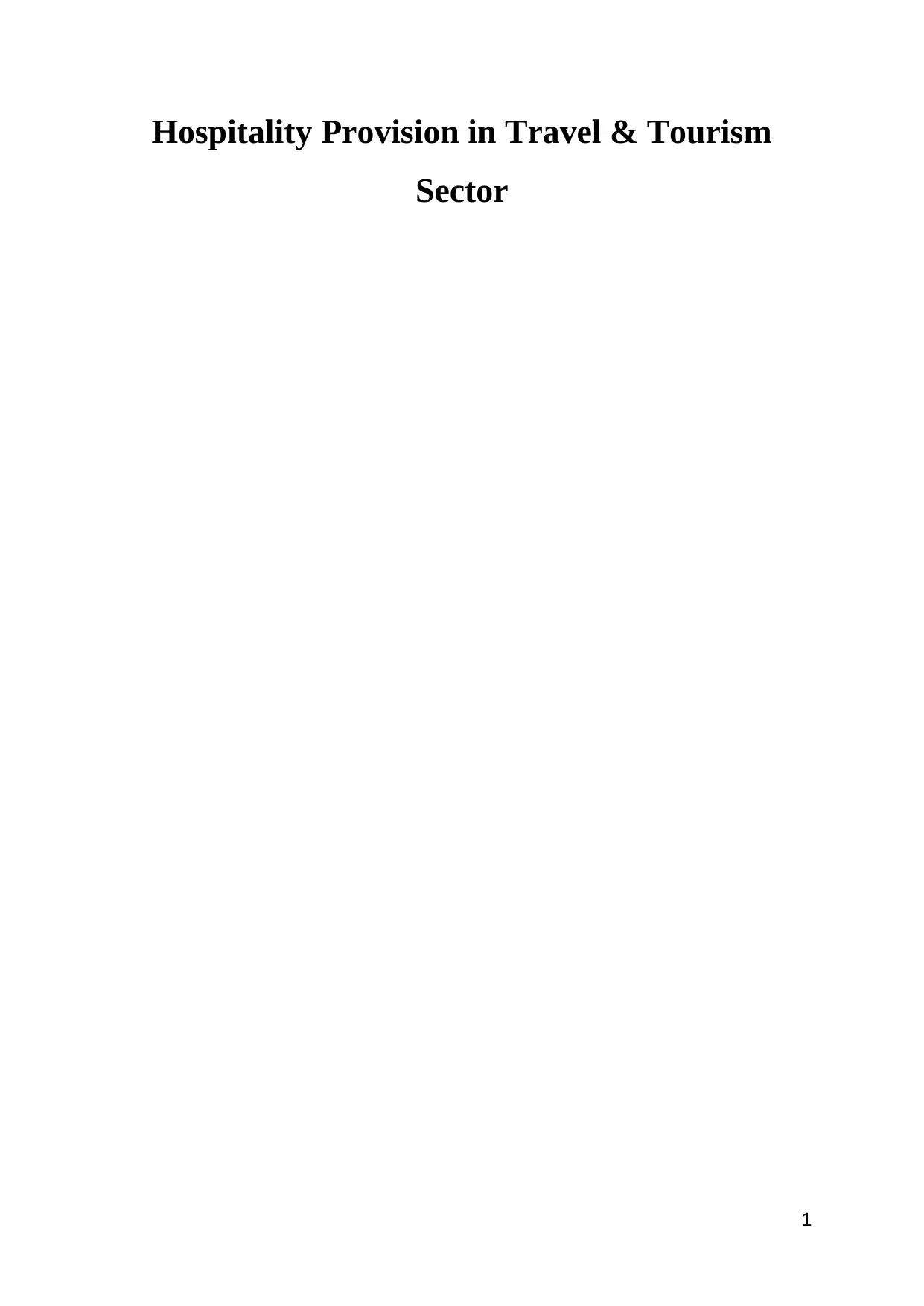
Hospitality Provision in Travel & Tourism
Sector
1
Sector
1
Secure Best Marks with AI Grader
Need help grading? Try our AI Grader for instant feedback on your assignments.
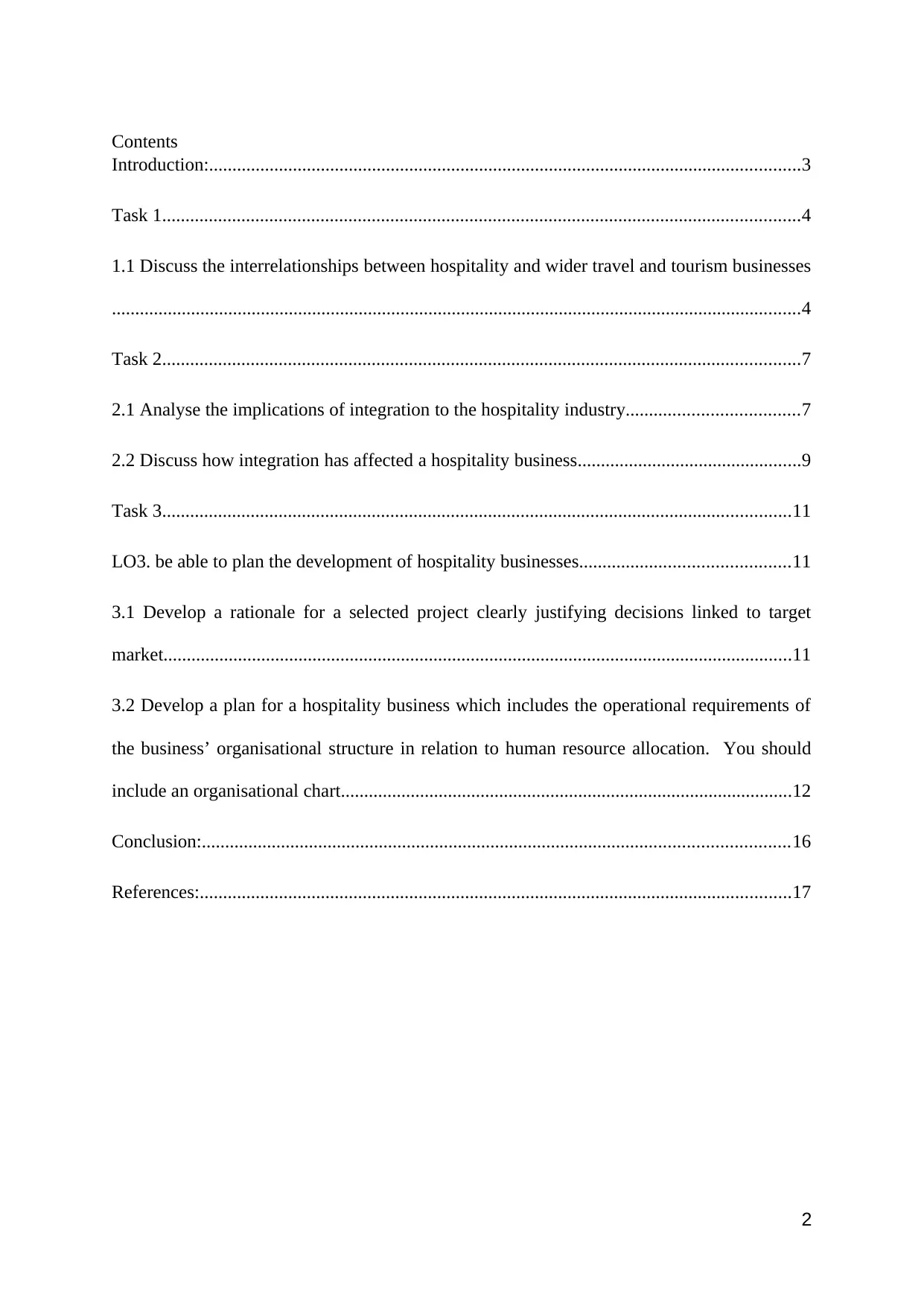
Contents
Introduction:...............................................................................................................................3
Task 1.........................................................................................................................................4
1.1 Discuss the interrelationships between hospitality and wider travel and tourism businesses
....................................................................................................................................................4
Task 2.........................................................................................................................................7
2.1 Analyse the implications of integration to the hospitality industry.....................................7
2.2 Discuss how integration has affected a hospitality business................................................9
Task 3.......................................................................................................................................11
LO3. be able to plan the development of hospitality businesses.............................................11
3.1 Develop a rationale for a selected project clearly justifying decisions linked to target
market.......................................................................................................................................11
3.2 Develop a plan for a hospitality business which includes the operational requirements of
the business’ organisational structure in relation to human resource allocation. You should
include an organisational chart.................................................................................................12
Conclusion:..............................................................................................................................16
References:...............................................................................................................................17
2
Introduction:...............................................................................................................................3
Task 1.........................................................................................................................................4
1.1 Discuss the interrelationships between hospitality and wider travel and tourism businesses
....................................................................................................................................................4
Task 2.........................................................................................................................................7
2.1 Analyse the implications of integration to the hospitality industry.....................................7
2.2 Discuss how integration has affected a hospitality business................................................9
Task 3.......................................................................................................................................11
LO3. be able to plan the development of hospitality businesses.............................................11
3.1 Develop a rationale for a selected project clearly justifying decisions linked to target
market.......................................................................................................................................11
3.2 Develop a plan for a hospitality business which includes the operational requirements of
the business’ organisational structure in relation to human resource allocation. You should
include an organisational chart.................................................................................................12
Conclusion:..............................................................................................................................16
References:...............................................................................................................................17
2
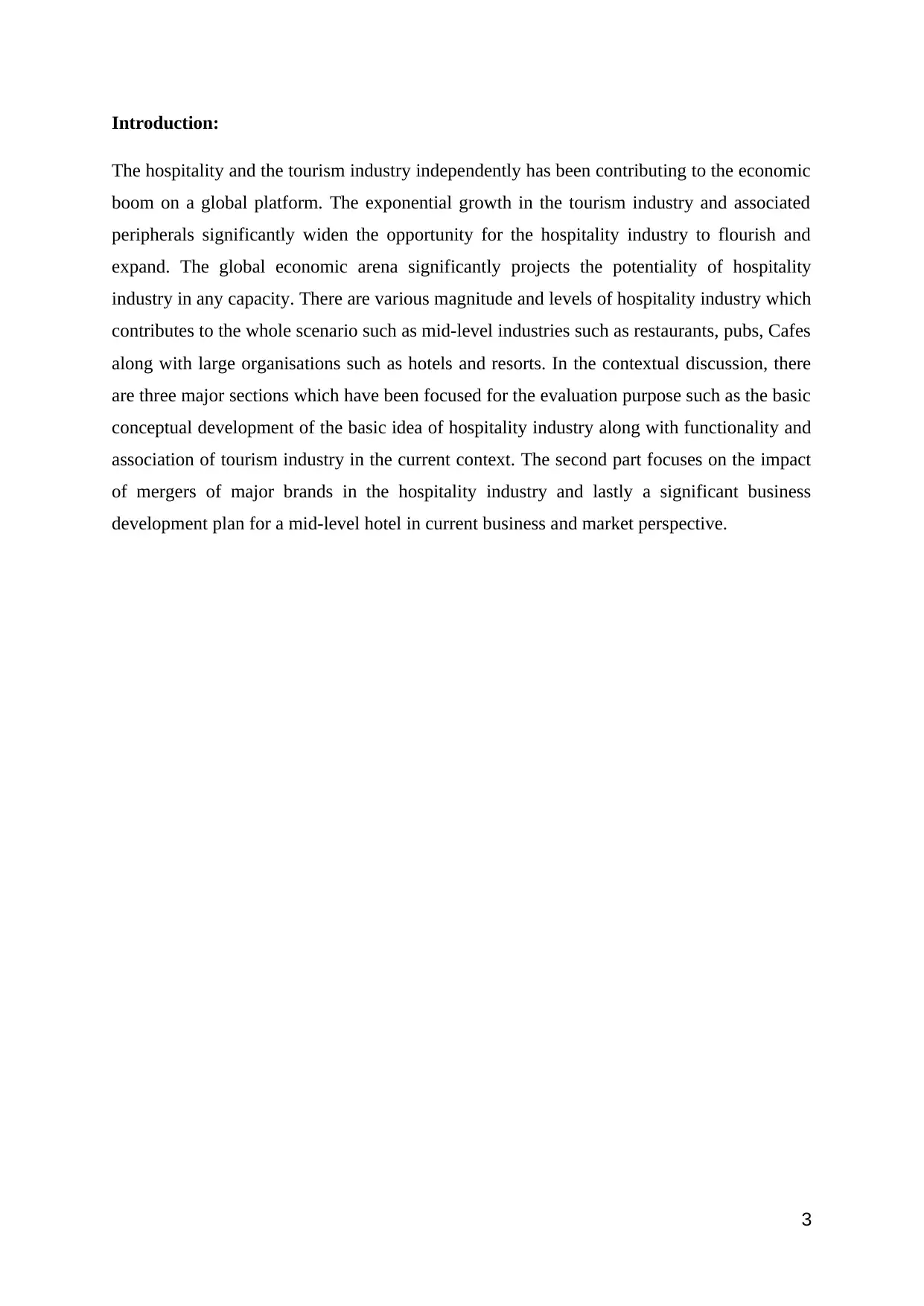
Introduction:
The hospitality and the tourism industry independently has been contributing to the economic
boom on a global platform. The exponential growth in the tourism industry and associated
peripherals significantly widen the opportunity for the hospitality industry to flourish and
expand. The global economic arena significantly projects the potentiality of hospitality
industry in any capacity. There are various magnitude and levels of hospitality industry which
contributes to the whole scenario such as mid-level industries such as restaurants, pubs, Cafes
along with large organisations such as hotels and resorts. In the contextual discussion, there
are three major sections which have been focused for the evaluation purpose such as the basic
conceptual development of the basic idea of hospitality industry along with functionality and
association of tourism industry in the current context. The second part focuses on the impact
of mergers of major brands in the hospitality industry and lastly a significant business
development plan for a mid-level hotel in current business and market perspective.
3
The hospitality and the tourism industry independently has been contributing to the economic
boom on a global platform. The exponential growth in the tourism industry and associated
peripherals significantly widen the opportunity for the hospitality industry to flourish and
expand. The global economic arena significantly projects the potentiality of hospitality
industry in any capacity. There are various magnitude and levels of hospitality industry which
contributes to the whole scenario such as mid-level industries such as restaurants, pubs, Cafes
along with large organisations such as hotels and resorts. In the contextual discussion, there
are three major sections which have been focused for the evaluation purpose such as the basic
conceptual development of the basic idea of hospitality industry along with functionality and
association of tourism industry in the current context. The second part focuses on the impact
of mergers of major brands in the hospitality industry and lastly a significant business
development plan for a mid-level hotel in current business and market perspective.
3
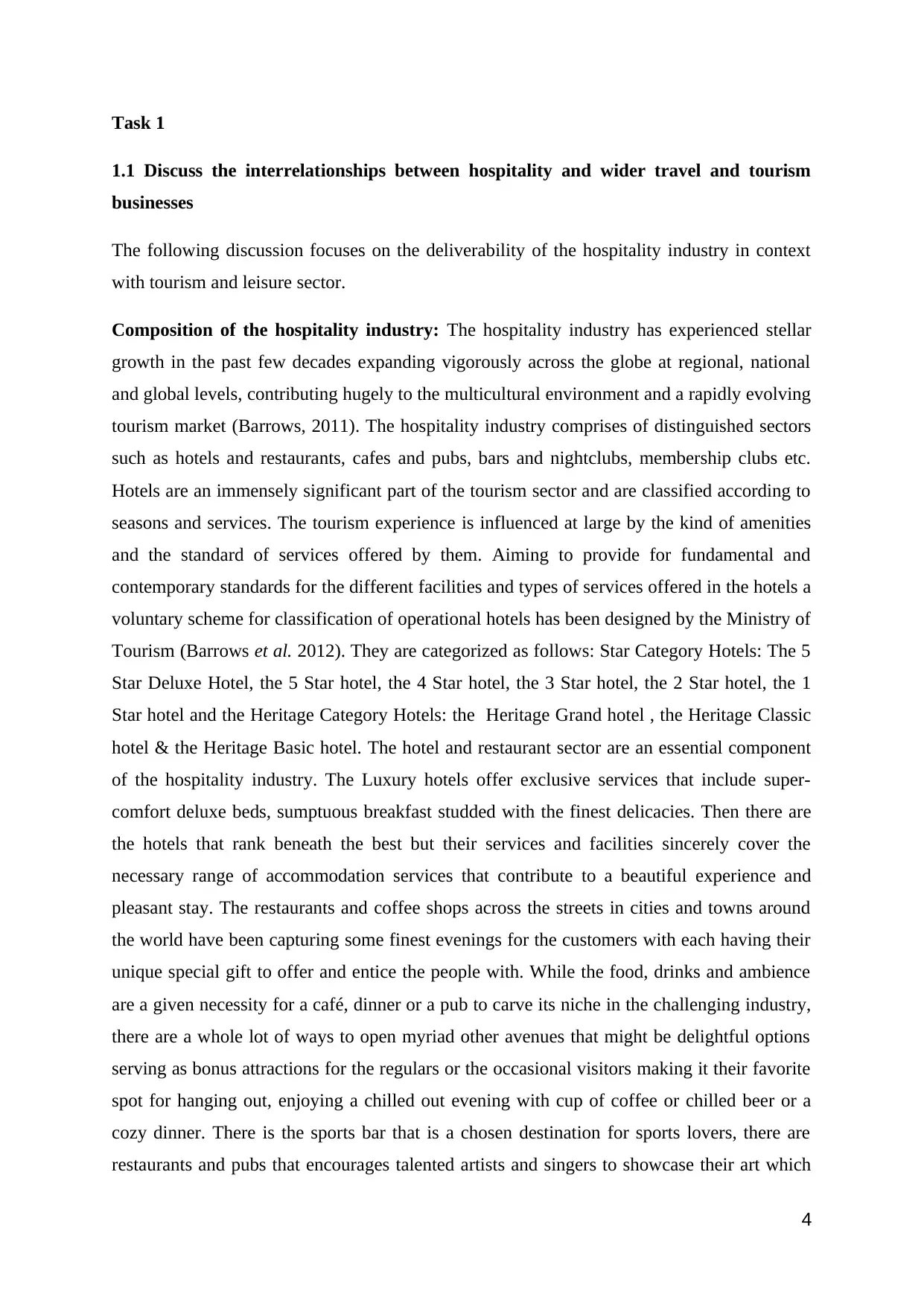
Task 1
1.1 Discuss the interrelationships between hospitality and wider travel and tourism
businesses
The following discussion focuses on the deliverability of the hospitality industry in context
with tourism and leisure sector.
Composition of the hospitality industry: The hospitality industry has experienced stellar
growth in the past few decades expanding vigorously across the globe at regional, national
and global levels, contributing hugely to the multicultural environment and a rapidly evolving
tourism market (Barrows, 2011). The hospitality industry comprises of distinguished sectors
such as hotels and restaurants, cafes and pubs, bars and nightclubs, membership clubs etc.
Hotels are an immensely significant part of the tourism sector and are classified according to
seasons and services. The tourism experience is influenced at large by the kind of amenities
and the standard of services offered by them. Aiming to provide for fundamental and
contemporary standards for the different facilities and types of services offered in the hotels a
voluntary scheme for classification of operational hotels has been designed by the Ministry of
Tourism (Barrows et al. 2012). They are categorized as follows: Star Category Hotels: The 5
Star Deluxe Hotel, the 5 Star hotel, the 4 Star hotel, the 3 Star hotel, the 2 Star hotel, the 1
Star hotel and the Heritage Category Hotels: the Heritage Grand hotel , the Heritage Classic
hotel & the Heritage Basic hotel. The hotel and restaurant sector are an essential component
of the hospitality industry. The Luxury hotels offer exclusive services that include super-
comfort deluxe beds, sumptuous breakfast studded with the finest delicacies. Then there are
the hotels that rank beneath the best but their services and facilities sincerely cover the
necessary range of accommodation services that contribute to a beautiful experience and
pleasant stay. The restaurants and coffee shops across the streets in cities and towns around
the world have been capturing some finest evenings for the customers with each having their
unique special gift to offer and entice the people with. While the food, drinks and ambience
are a given necessity for a café, dinner or a pub to carve its niche in the challenging industry,
there are a whole lot of ways to open myriad other avenues that might be delightful options
serving as bonus attractions for the regulars or the occasional visitors making it their favorite
spot for hanging out, enjoying a chilled out evening with cup of coffee or chilled beer or a
cozy dinner. There is the sports bar that is a chosen destination for sports lovers, there are
restaurants and pubs that encourages talented artists and singers to showcase their art which
4
1.1 Discuss the interrelationships between hospitality and wider travel and tourism
businesses
The following discussion focuses on the deliverability of the hospitality industry in context
with tourism and leisure sector.
Composition of the hospitality industry: The hospitality industry has experienced stellar
growth in the past few decades expanding vigorously across the globe at regional, national
and global levels, contributing hugely to the multicultural environment and a rapidly evolving
tourism market (Barrows, 2011). The hospitality industry comprises of distinguished sectors
such as hotels and restaurants, cafes and pubs, bars and nightclubs, membership clubs etc.
Hotels are an immensely significant part of the tourism sector and are classified according to
seasons and services. The tourism experience is influenced at large by the kind of amenities
and the standard of services offered by them. Aiming to provide for fundamental and
contemporary standards for the different facilities and types of services offered in the hotels a
voluntary scheme for classification of operational hotels has been designed by the Ministry of
Tourism (Barrows et al. 2012). They are categorized as follows: Star Category Hotels: The 5
Star Deluxe Hotel, the 5 Star hotel, the 4 Star hotel, the 3 Star hotel, the 2 Star hotel, the 1
Star hotel and the Heritage Category Hotels: the Heritage Grand hotel , the Heritage Classic
hotel & the Heritage Basic hotel. The hotel and restaurant sector are an essential component
of the hospitality industry. The Luxury hotels offer exclusive services that include super-
comfort deluxe beds, sumptuous breakfast studded with the finest delicacies. Then there are
the hotels that rank beneath the best but their services and facilities sincerely cover the
necessary range of accommodation services that contribute to a beautiful experience and
pleasant stay. The restaurants and coffee shops across the streets in cities and towns around
the world have been capturing some finest evenings for the customers with each having their
unique special gift to offer and entice the people with. While the food, drinks and ambience
are a given necessity for a café, dinner or a pub to carve its niche in the challenging industry,
there are a whole lot of ways to open myriad other avenues that might be delightful options
serving as bonus attractions for the regulars or the occasional visitors making it their favorite
spot for hanging out, enjoying a chilled out evening with cup of coffee or chilled beer or a
cozy dinner. There is the sports bar that is a chosen destination for sports lovers, there are
restaurants and pubs that encourages talented artists and singers to showcase their art which
4
Secure Best Marks with AI Grader
Need help grading? Try our AI Grader for instant feedback on your assignments.
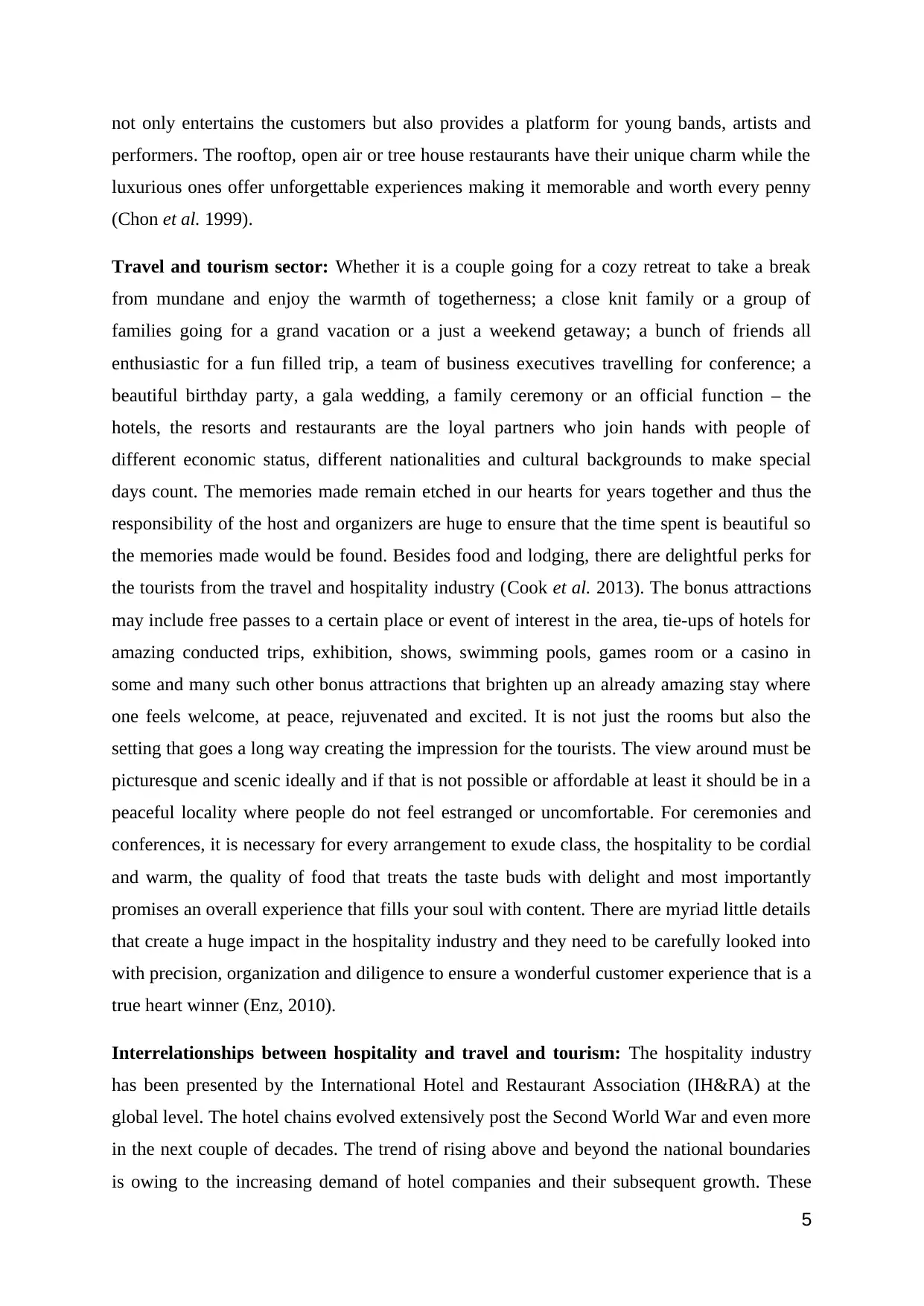
not only entertains the customers but also provides a platform for young bands, artists and
performers. The rooftop, open air or tree house restaurants have their unique charm while the
luxurious ones offer unforgettable experiences making it memorable and worth every penny
(Chon et al. 1999).
Travel and tourism sector: Whether it is a couple going for a cozy retreat to take a break
from mundane and enjoy the warmth of togetherness; a close knit family or a group of
families going for a grand vacation or a just a weekend getaway; a bunch of friends all
enthusiastic for a fun filled trip, a team of business executives travelling for conference; a
beautiful birthday party, a gala wedding, a family ceremony or an official function – the
hotels, the resorts and restaurants are the loyal partners who join hands with people of
different economic status, different nationalities and cultural backgrounds to make special
days count. The memories made remain etched in our hearts for years together and thus the
responsibility of the host and organizers are huge to ensure that the time spent is beautiful so
the memories made would be found. Besides food and lodging, there are delightful perks for
the tourists from the travel and hospitality industry (Cook et al. 2013). The bonus attractions
may include free passes to a certain place or event of interest in the area, tie-ups of hotels for
amazing conducted trips, exhibition, shows, swimming pools, games room or a casino in
some and many such other bonus attractions that brighten up an already amazing stay where
one feels welcome, at peace, rejuvenated and excited. It is not just the rooms but also the
setting that goes a long way creating the impression for the tourists. The view around must be
picturesque and scenic ideally and if that is not possible or affordable at least it should be in a
peaceful locality where people do not feel estranged or uncomfortable. For ceremonies and
conferences, it is necessary for every arrangement to exude class, the hospitality to be cordial
and warm, the quality of food that treats the taste buds with delight and most importantly
promises an overall experience that fills your soul with content. There are myriad little details
that create a huge impact in the hospitality industry and they need to be carefully looked into
with precision, organization and diligence to ensure a wonderful customer experience that is a
true heart winner (Enz, 2010).
Interrelationships between hospitality and travel and tourism: The hospitality industry
has been presented by the International Hotel and Restaurant Association (IH&RA) at the
global level. The hotel chains evolved extensively post the Second World War and even more
in the next couple of decades. The trend of rising above and beyond the national boundaries
is owing to the increasing demand of hotel companies and their subsequent growth. These
5
performers. The rooftop, open air or tree house restaurants have their unique charm while the
luxurious ones offer unforgettable experiences making it memorable and worth every penny
(Chon et al. 1999).
Travel and tourism sector: Whether it is a couple going for a cozy retreat to take a break
from mundane and enjoy the warmth of togetherness; a close knit family or a group of
families going for a grand vacation or a just a weekend getaway; a bunch of friends all
enthusiastic for a fun filled trip, a team of business executives travelling for conference; a
beautiful birthday party, a gala wedding, a family ceremony or an official function – the
hotels, the resorts and restaurants are the loyal partners who join hands with people of
different economic status, different nationalities and cultural backgrounds to make special
days count. The memories made remain etched in our hearts for years together and thus the
responsibility of the host and organizers are huge to ensure that the time spent is beautiful so
the memories made would be found. Besides food and lodging, there are delightful perks for
the tourists from the travel and hospitality industry (Cook et al. 2013). The bonus attractions
may include free passes to a certain place or event of interest in the area, tie-ups of hotels for
amazing conducted trips, exhibition, shows, swimming pools, games room or a casino in
some and many such other bonus attractions that brighten up an already amazing stay where
one feels welcome, at peace, rejuvenated and excited. It is not just the rooms but also the
setting that goes a long way creating the impression for the tourists. The view around must be
picturesque and scenic ideally and if that is not possible or affordable at least it should be in a
peaceful locality where people do not feel estranged or uncomfortable. For ceremonies and
conferences, it is necessary for every arrangement to exude class, the hospitality to be cordial
and warm, the quality of food that treats the taste buds with delight and most importantly
promises an overall experience that fills your soul with content. There are myriad little details
that create a huge impact in the hospitality industry and they need to be carefully looked into
with precision, organization and diligence to ensure a wonderful customer experience that is a
true heart winner (Enz, 2010).
Interrelationships between hospitality and travel and tourism: The hospitality industry
has been presented by the International Hotel and Restaurant Association (IH&RA) at the
global level. The hotel chains evolved extensively post the Second World War and even more
in the next couple of decades. The trend of rising above and beyond the national boundaries
is owing to the increasing demand of hotel companies and their subsequent growth. These
5
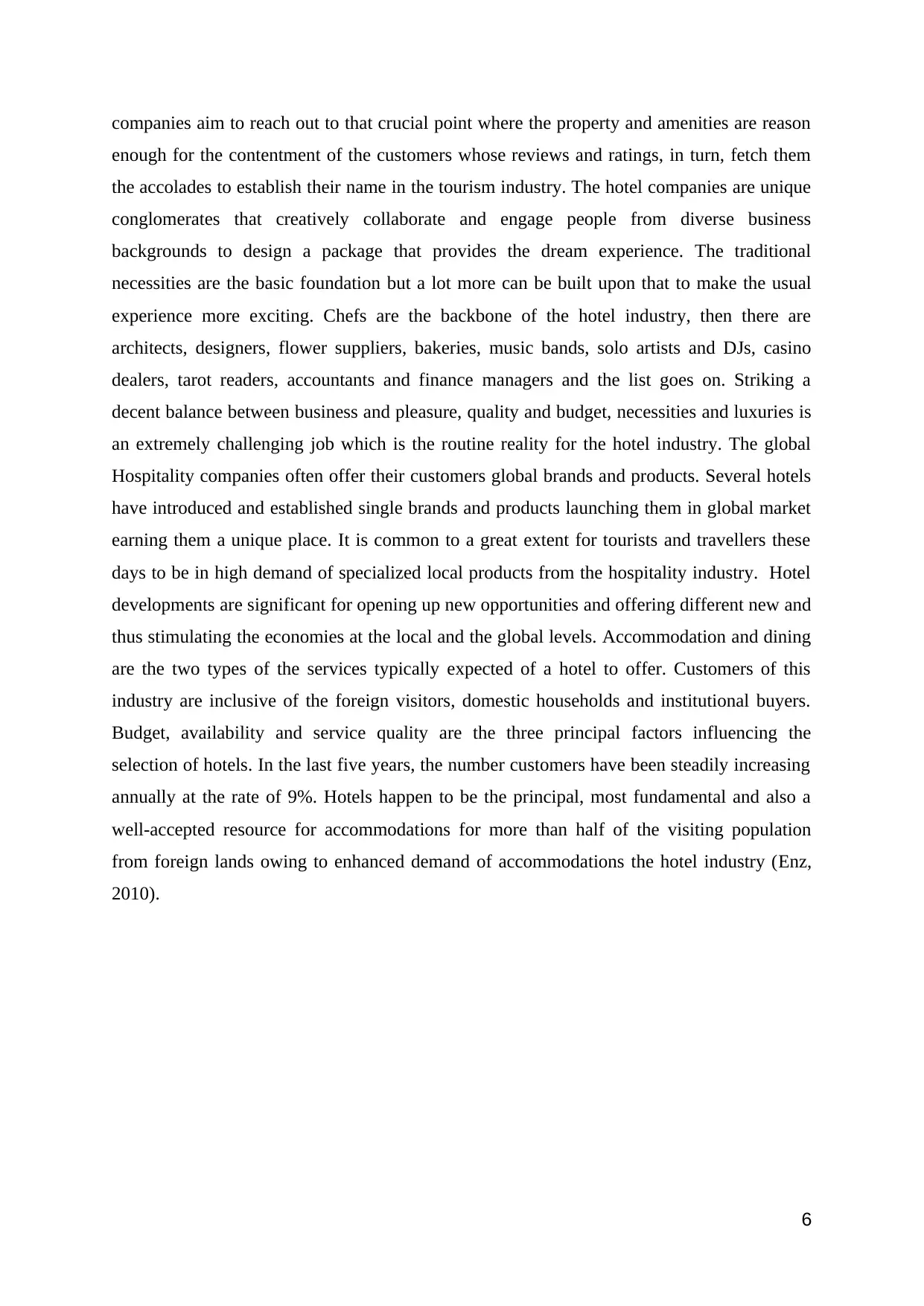
companies aim to reach out to that crucial point where the property and amenities are reason
enough for the contentment of the customers whose reviews and ratings, in turn, fetch them
the accolades to establish their name in the tourism industry. The hotel companies are unique
conglomerates that creatively collaborate and engage people from diverse business
backgrounds to design a package that provides the dream experience. The traditional
necessities are the basic foundation but a lot more can be built upon that to make the usual
experience more exciting. Chefs are the backbone of the hotel industry, then there are
architects, designers, flower suppliers, bakeries, music bands, solo artists and DJs, casino
dealers, tarot readers, accountants and finance managers and the list goes on. Striking a
decent balance between business and pleasure, quality and budget, necessities and luxuries is
an extremely challenging job which is the routine reality for the hotel industry. The global
Hospitality companies often offer their customers global brands and products. Several hotels
have introduced and established single brands and products launching them in global market
earning them a unique place. It is common to a great extent for tourists and travellers these
days to be in high demand of specialized local products from the hospitality industry. Hotel
developments are significant for opening up new opportunities and offering different new and
thus stimulating the economies at the local and the global levels. Accommodation and dining
are the two types of the services typically expected of a hotel to offer. Customers of this
industry are inclusive of the foreign visitors, domestic households and institutional buyers.
Budget, availability and service quality are the three principal factors influencing the
selection of hotels. In the last five years, the number customers have been steadily increasing
annually at the rate of 9%. Hotels happen to be the principal, most fundamental and also a
well-accepted resource for accommodations for more than half of the visiting population
from foreign lands owing to enhanced demand of accommodations the hotel industry (Enz,
2010).
6
enough for the contentment of the customers whose reviews and ratings, in turn, fetch them
the accolades to establish their name in the tourism industry. The hotel companies are unique
conglomerates that creatively collaborate and engage people from diverse business
backgrounds to design a package that provides the dream experience. The traditional
necessities are the basic foundation but a lot more can be built upon that to make the usual
experience more exciting. Chefs are the backbone of the hotel industry, then there are
architects, designers, flower suppliers, bakeries, music bands, solo artists and DJs, casino
dealers, tarot readers, accountants and finance managers and the list goes on. Striking a
decent balance between business and pleasure, quality and budget, necessities and luxuries is
an extremely challenging job which is the routine reality for the hotel industry. The global
Hospitality companies often offer their customers global brands and products. Several hotels
have introduced and established single brands and products launching them in global market
earning them a unique place. It is common to a great extent for tourists and travellers these
days to be in high demand of specialized local products from the hospitality industry. Hotel
developments are significant for opening up new opportunities and offering different new and
thus stimulating the economies at the local and the global levels. Accommodation and dining
are the two types of the services typically expected of a hotel to offer. Customers of this
industry are inclusive of the foreign visitors, domestic households and institutional buyers.
Budget, availability and service quality are the three principal factors influencing the
selection of hotels. In the last five years, the number customers have been steadily increasing
annually at the rate of 9%. Hotels happen to be the principal, most fundamental and also a
well-accepted resource for accommodations for more than half of the visiting population
from foreign lands owing to enhanced demand of accommodations the hotel industry (Enz,
2010).
6
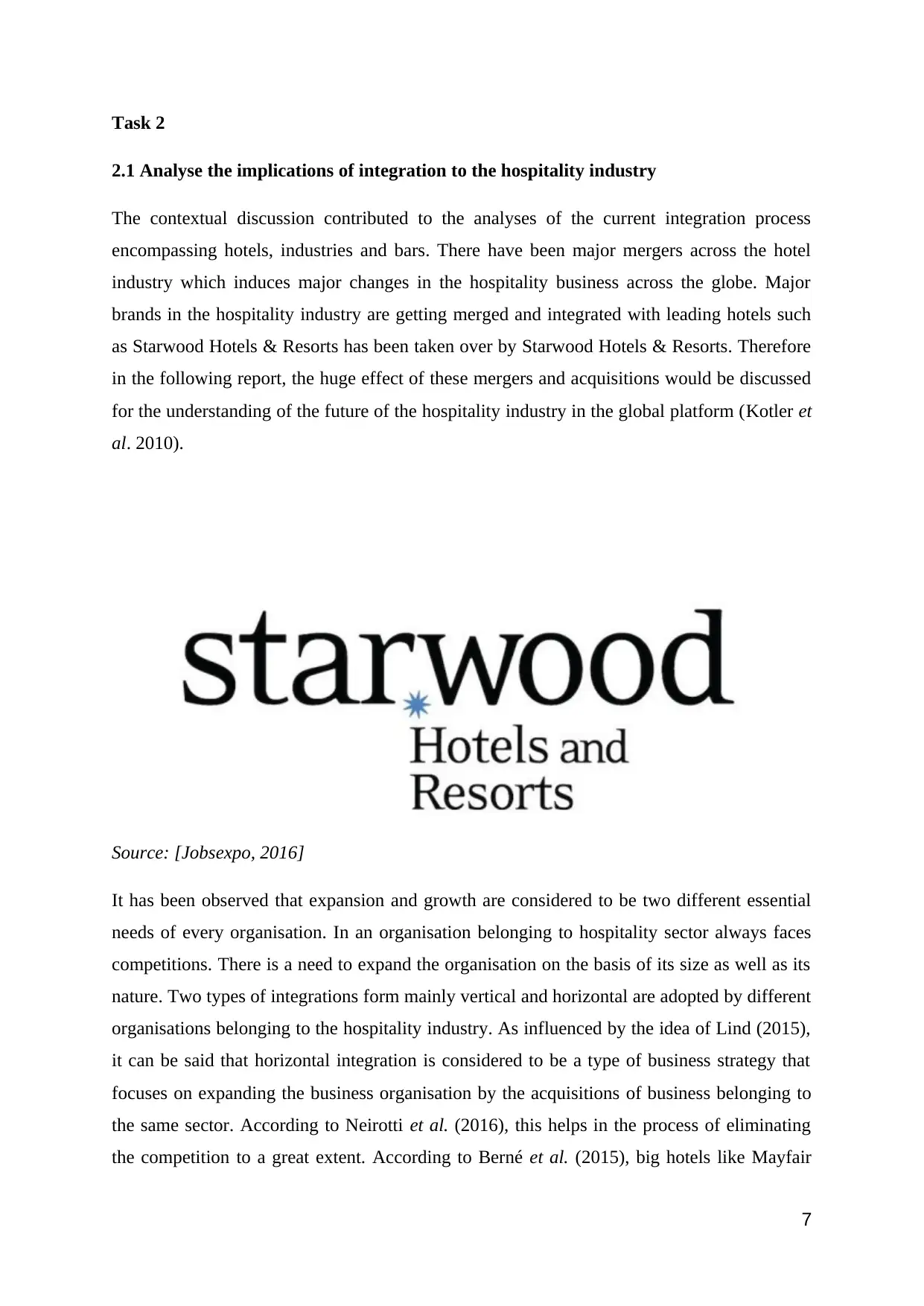
Task 2
2.1 Analyse the implications of integration to the hospitality industry
The contextual discussion contributed to the analyses of the current integration process
encompassing hotels, industries and bars. There have been major mergers across the hotel
industry which induces major changes in the hospitality business across the globe. Major
brands in the hospitality industry are getting merged and integrated with leading hotels such
as Starwood Hotels & Resorts has been taken over by Starwood Hotels & Resorts. Therefore
in the following report, the huge effect of these mergers and acquisitions would be discussed
for the understanding of the future of the hospitality industry in the global platform (Kotler et
al. 2010).
Source: [Jobsexpo, 2016]
It has been observed that expansion and growth are considered to be two different essential
needs of every organisation. In an organisation belonging to hospitality sector always faces
competitions. There is a need to expand the organisation on the basis of its size as well as its
nature. Two types of integrations form mainly vertical and horizontal are adopted by different
organisations belonging to the hospitality industry. As influenced by the idea of Lind (2015),
it can be said that horizontal integration is considered to be a type of business strategy that
focuses on expanding the business organisation by the acquisitions of business belonging to
the same sector. According to Neirotti et al. (2016), this helps in the process of eliminating
the competition to a great extent. According to Berné et al. (2015), big hotels like Mayfair
7
2.1 Analyse the implications of integration to the hospitality industry
The contextual discussion contributed to the analyses of the current integration process
encompassing hotels, industries and bars. There have been major mergers across the hotel
industry which induces major changes in the hospitality business across the globe. Major
brands in the hospitality industry are getting merged and integrated with leading hotels such
as Starwood Hotels & Resorts has been taken over by Starwood Hotels & Resorts. Therefore
in the following report, the huge effect of these mergers and acquisitions would be discussed
for the understanding of the future of the hospitality industry in the global platform (Kotler et
al. 2010).
Source: [Jobsexpo, 2016]
It has been observed that expansion and growth are considered to be two different essential
needs of every organisation. In an organisation belonging to hospitality sector always faces
competitions. There is a need to expand the organisation on the basis of its size as well as its
nature. Two types of integrations form mainly vertical and horizontal are adopted by different
organisations belonging to the hospitality industry. As influenced by the idea of Lind (2015),
it can be said that horizontal integration is considered to be a type of business strategy that
focuses on expanding the business organisation by the acquisitions of business belonging to
the same sector. According to Neirotti et al. (2016), this helps in the process of eliminating
the competition to a great extent. According to Berné et al. (2015), big hotels like Mayfair
7
Paraphrase This Document
Need a fresh take? Get an instant paraphrase of this document with our AI Paraphraser
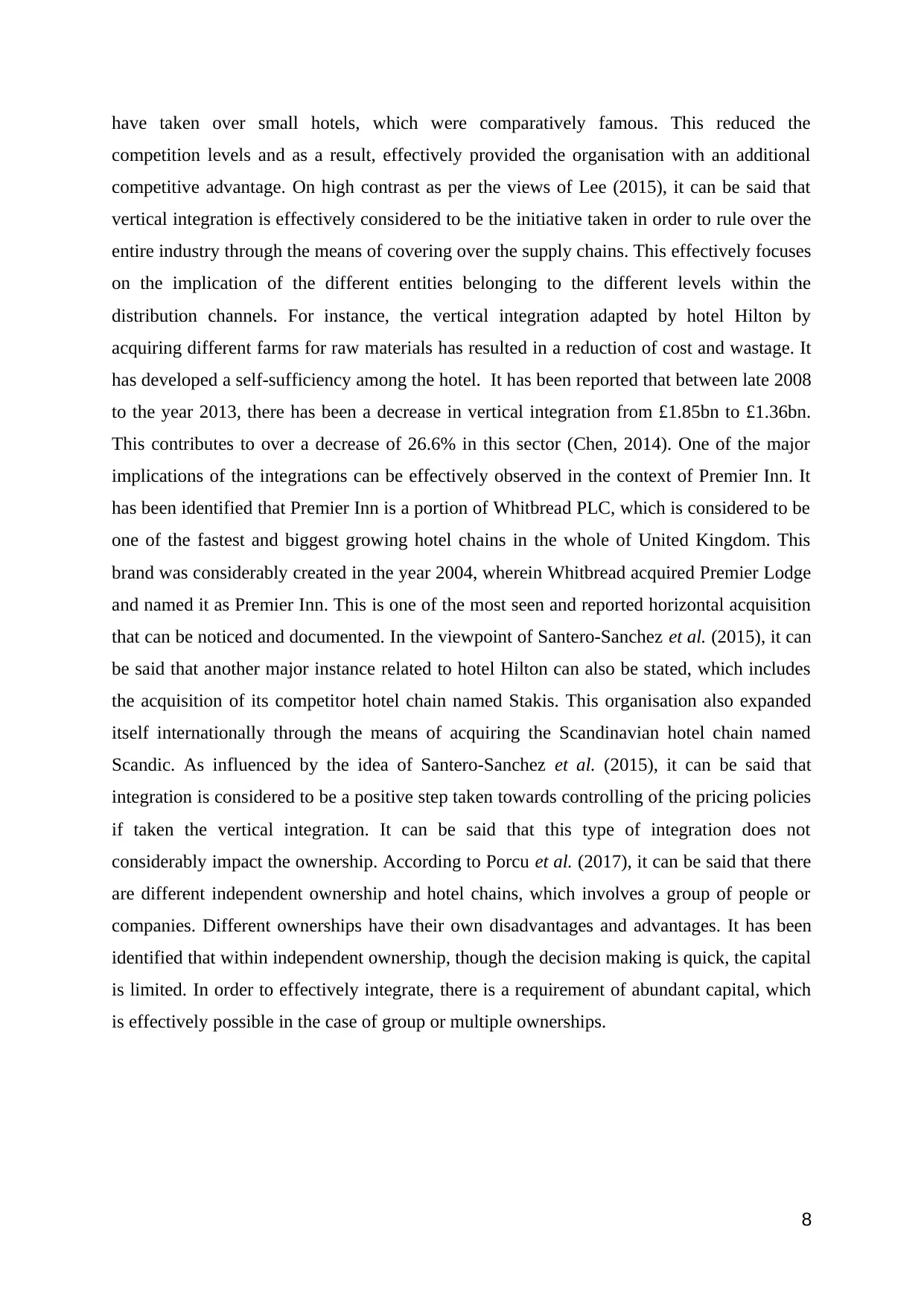
have taken over small hotels, which were comparatively famous. This reduced the
competition levels and as a result, effectively provided the organisation with an additional
competitive advantage. On high contrast as per the views of Lee (2015), it can be said that
vertical integration is effectively considered to be the initiative taken in order to rule over the
entire industry through the means of covering over the supply chains. This effectively focuses
on the implication of the different entities belonging to the different levels within the
distribution channels. For instance, the vertical integration adapted by hotel Hilton by
acquiring different farms for raw materials has resulted in a reduction of cost and wastage. It
has developed a self-sufficiency among the hotel. It has been reported that between late 2008
to the year 2013, there has been a decrease in vertical integration from £1.85bn to £1.36bn.
This contributes to over a decrease of 26.6% in this sector (Chen, 2014). One of the major
implications of the integrations can be effectively observed in the context of Premier Inn. It
has been identified that Premier Inn is a portion of Whitbread PLC, which is considered to be
one of the fastest and biggest growing hotel chains in the whole of United Kingdom. This
brand was considerably created in the year 2004, wherein Whitbread acquired Premier Lodge
and named it as Premier Inn. This is one of the most seen and reported horizontal acquisition
that can be noticed and documented. In the viewpoint of Santero-Sanchez et al. (2015), it can
be said that another major instance related to hotel Hilton can also be stated, which includes
the acquisition of its competitor hotel chain named Stakis. This organisation also expanded
itself internationally through the means of acquiring the Scandinavian hotel chain named
Scandic. As influenced by the idea of Santero-Sanchez et al. (2015), it can be said that
integration is considered to be a positive step taken towards controlling of the pricing policies
if taken the vertical integration. It can be said that this type of integration does not
considerably impact the ownership. According to Porcu et al. (2017), it can be said that there
are different independent ownership and hotel chains, which involves a group of people or
companies. Different ownerships have their own disadvantages and advantages. It has been
identified that within independent ownership, though the decision making is quick, the capital
is limited. In order to effectively integrate, there is a requirement of abundant capital, which
is effectively possible in the case of group or multiple ownerships.
8
competition levels and as a result, effectively provided the organisation with an additional
competitive advantage. On high contrast as per the views of Lee (2015), it can be said that
vertical integration is effectively considered to be the initiative taken in order to rule over the
entire industry through the means of covering over the supply chains. This effectively focuses
on the implication of the different entities belonging to the different levels within the
distribution channels. For instance, the vertical integration adapted by hotel Hilton by
acquiring different farms for raw materials has resulted in a reduction of cost and wastage. It
has developed a self-sufficiency among the hotel. It has been reported that between late 2008
to the year 2013, there has been a decrease in vertical integration from £1.85bn to £1.36bn.
This contributes to over a decrease of 26.6% in this sector (Chen, 2014). One of the major
implications of the integrations can be effectively observed in the context of Premier Inn. It
has been identified that Premier Inn is a portion of Whitbread PLC, which is considered to be
one of the fastest and biggest growing hotel chains in the whole of United Kingdom. This
brand was considerably created in the year 2004, wherein Whitbread acquired Premier Lodge
and named it as Premier Inn. This is one of the most seen and reported horizontal acquisition
that can be noticed and documented. In the viewpoint of Santero-Sanchez et al. (2015), it can
be said that another major instance related to hotel Hilton can also be stated, which includes
the acquisition of its competitor hotel chain named Stakis. This organisation also expanded
itself internationally through the means of acquiring the Scandinavian hotel chain named
Scandic. As influenced by the idea of Santero-Sanchez et al. (2015), it can be said that
integration is considered to be a positive step taken towards controlling of the pricing policies
if taken the vertical integration. It can be said that this type of integration does not
considerably impact the ownership. According to Porcu et al. (2017), it can be said that there
are different independent ownership and hotel chains, which involves a group of people or
companies. Different ownerships have their own disadvantages and advantages. It has been
identified that within independent ownership, though the decision making is quick, the capital
is limited. In order to effectively integrate, there is a requirement of abundant capital, which
is effectively possible in the case of group or multiple ownerships.
8
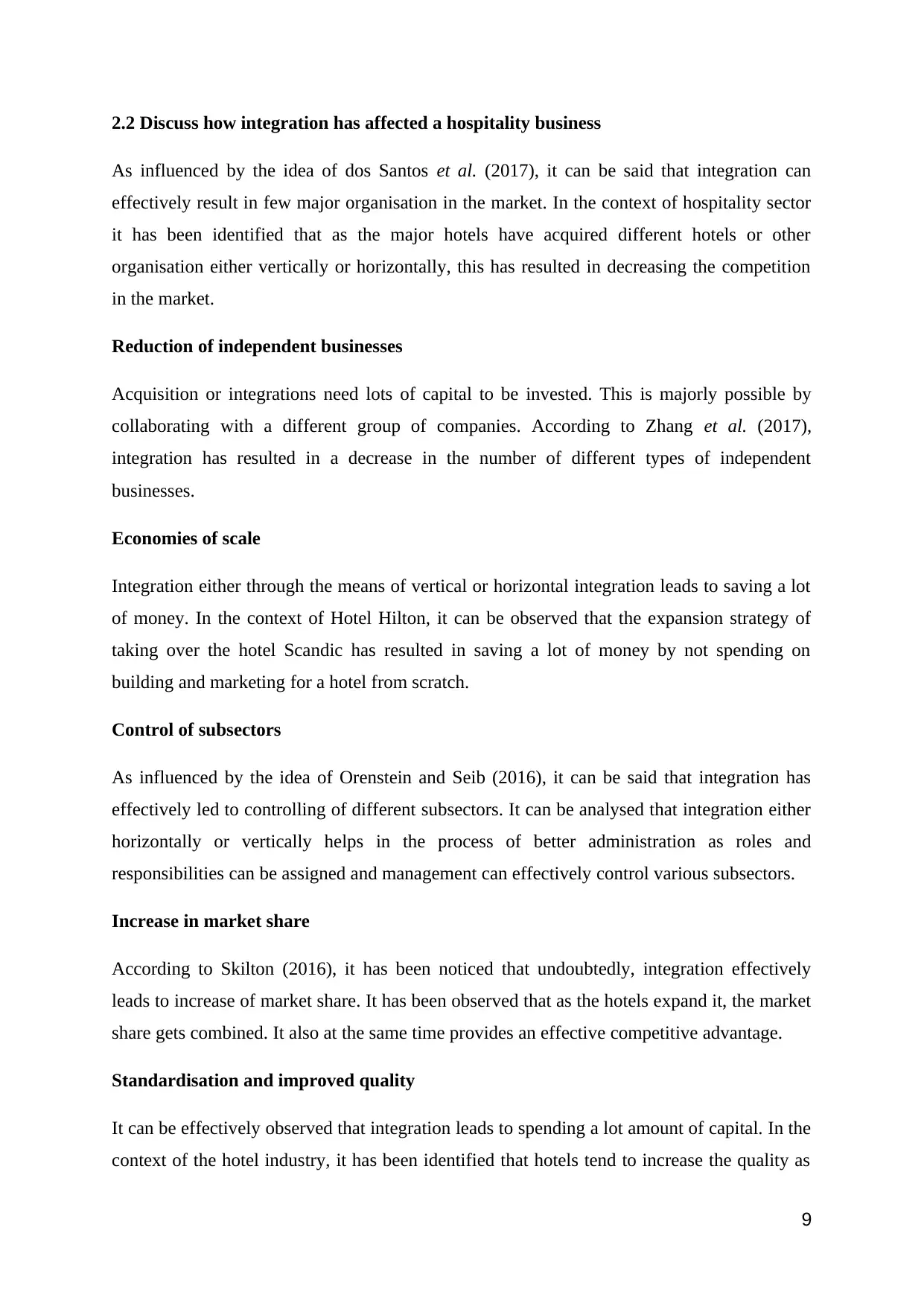
2.2 Discuss how integration has affected a hospitality business
As influenced by the idea of dos Santos et al. (2017), it can be said that integration can
effectively result in few major organisation in the market. In the context of hospitality sector
it has been identified that as the major hotels have acquired different hotels or other
organisation either vertically or horizontally, this has resulted in decreasing the competition
in the market.
Reduction of independent businesses
Acquisition or integrations need lots of capital to be invested. This is majorly possible by
collaborating with a different group of companies. According to Zhang et al. (2017),
integration has resulted in a decrease in the number of different types of independent
businesses.
Economies of scale
Integration either through the means of vertical or horizontal integration leads to saving a lot
of money. In the context of Hotel Hilton, it can be observed that the expansion strategy of
taking over the hotel Scandic has resulted in saving a lot of money by not spending on
building and marketing for a hotel from scratch.
Control of subsectors
As influenced by the idea of Orenstein and Seib (2016), it can be said that integration has
effectively led to controlling of different subsectors. It can be analysed that integration either
horizontally or vertically helps in the process of better administration as roles and
responsibilities can be assigned and management can effectively control various subsectors.
Increase in market share
According to Skilton (2016), it has been noticed that undoubtedly, integration effectively
leads to increase of market share. It has been observed that as the hotels expand it, the market
share gets combined. It also at the same time provides an effective competitive advantage.
Standardisation and improved quality
It can be effectively observed that integration leads to spending a lot amount of capital. In the
context of the hotel industry, it has been identified that hotels tend to increase the quality as
9
As influenced by the idea of dos Santos et al. (2017), it can be said that integration can
effectively result in few major organisation in the market. In the context of hospitality sector
it has been identified that as the major hotels have acquired different hotels or other
organisation either vertically or horizontally, this has resulted in decreasing the competition
in the market.
Reduction of independent businesses
Acquisition or integrations need lots of capital to be invested. This is majorly possible by
collaborating with a different group of companies. According to Zhang et al. (2017),
integration has resulted in a decrease in the number of different types of independent
businesses.
Economies of scale
Integration either through the means of vertical or horizontal integration leads to saving a lot
of money. In the context of Hotel Hilton, it can be observed that the expansion strategy of
taking over the hotel Scandic has resulted in saving a lot of money by not spending on
building and marketing for a hotel from scratch.
Control of subsectors
As influenced by the idea of Orenstein and Seib (2016), it can be said that integration has
effectively led to controlling of different subsectors. It can be analysed that integration either
horizontally or vertically helps in the process of better administration as roles and
responsibilities can be assigned and management can effectively control various subsectors.
Increase in market share
According to Skilton (2016), it has been noticed that undoubtedly, integration effectively
leads to increase of market share. It has been observed that as the hotels expand it, the market
share gets combined. It also at the same time provides an effective competitive advantage.
Standardisation and improved quality
It can be effectively observed that integration leads to spending a lot amount of capital. In the
context of the hotel industry, it has been identified that hotels tend to increase the quality as
9
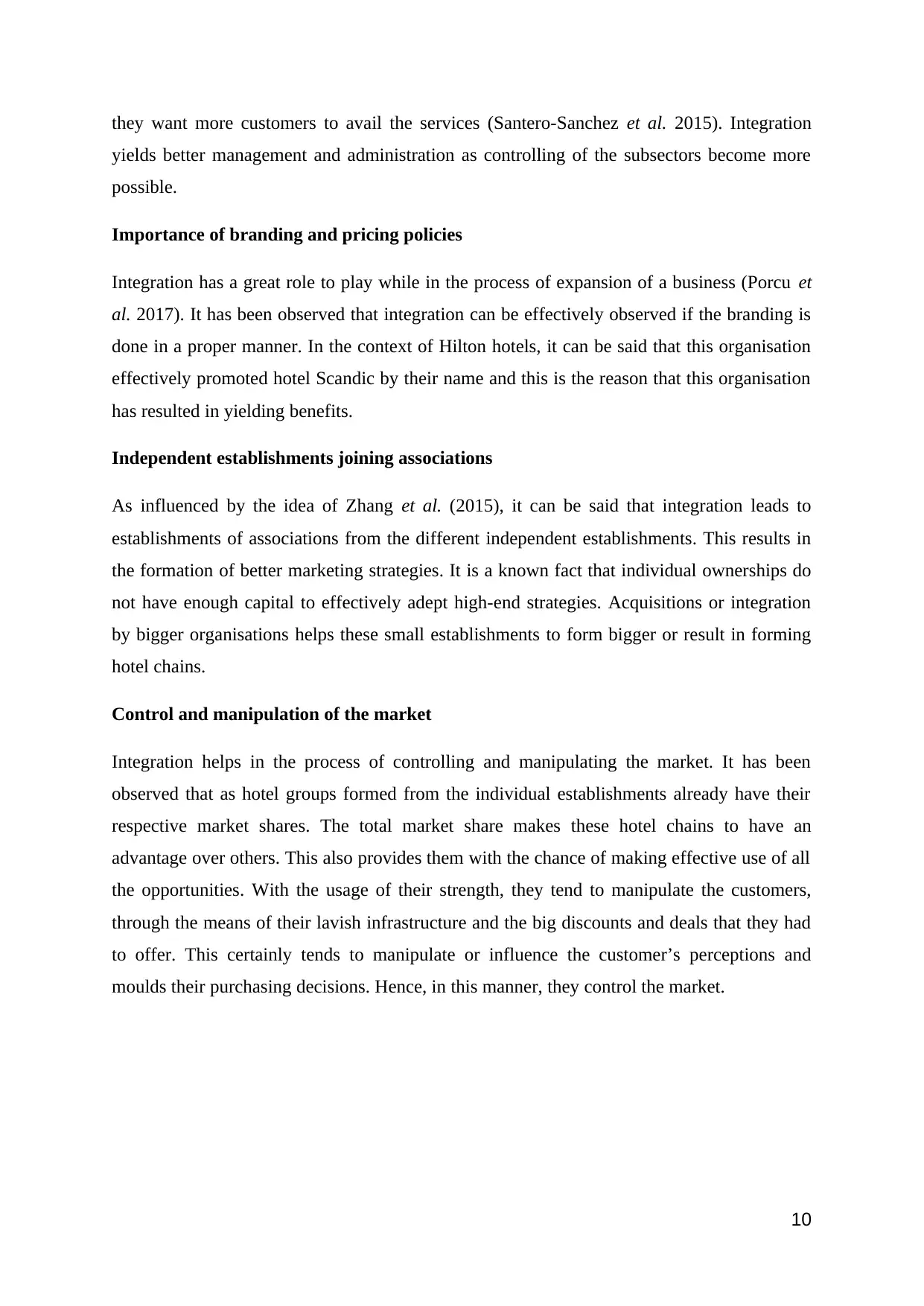
they want more customers to avail the services (Santero-Sanchez et al. 2015). Integration
yields better management and administration as controlling of the subsectors become more
possible.
Importance of branding and pricing policies
Integration has a great role to play while in the process of expansion of a business (Porcu et
al. 2017). It has been observed that integration can be effectively observed if the branding is
done in a proper manner. In the context of Hilton hotels, it can be said that this organisation
effectively promoted hotel Scandic by their name and this is the reason that this organisation
has resulted in yielding benefits.
Independent establishments joining associations
As influenced by the idea of Zhang et al. (2015), it can be said that integration leads to
establishments of associations from the different independent establishments. This results in
the formation of better marketing strategies. It is a known fact that individual ownerships do
not have enough capital to effectively adept high-end strategies. Acquisitions or integration
by bigger organisations helps these small establishments to form bigger or result in forming
hotel chains.
Control and manipulation of the market
Integration helps in the process of controlling and manipulating the market. It has been
observed that as hotel groups formed from the individual establishments already have their
respective market shares. The total market share makes these hotel chains to have an
advantage over others. This also provides them with the chance of making effective use of all
the opportunities. With the usage of their strength, they tend to manipulate the customers,
through the means of their lavish infrastructure and the big discounts and deals that they had
to offer. This certainly tends to manipulate or influence the customer’s perceptions and
moulds their purchasing decisions. Hence, in this manner, they control the market.
10
yields better management and administration as controlling of the subsectors become more
possible.
Importance of branding and pricing policies
Integration has a great role to play while in the process of expansion of a business (Porcu et
al. 2017). It has been observed that integration can be effectively observed if the branding is
done in a proper manner. In the context of Hilton hotels, it can be said that this organisation
effectively promoted hotel Scandic by their name and this is the reason that this organisation
has resulted in yielding benefits.
Independent establishments joining associations
As influenced by the idea of Zhang et al. (2015), it can be said that integration leads to
establishments of associations from the different independent establishments. This results in
the formation of better marketing strategies. It is a known fact that individual ownerships do
not have enough capital to effectively adept high-end strategies. Acquisitions or integration
by bigger organisations helps these small establishments to form bigger or result in forming
hotel chains.
Control and manipulation of the market
Integration helps in the process of controlling and manipulating the market. It has been
observed that as hotel groups formed from the individual establishments already have their
respective market shares. The total market share makes these hotel chains to have an
advantage over others. This also provides them with the chance of making effective use of all
the opportunities. With the usage of their strength, they tend to manipulate the customers,
through the means of their lavish infrastructure and the big discounts and deals that they had
to offer. This certainly tends to manipulate or influence the customer’s perceptions and
moulds their purchasing decisions. Hence, in this manner, they control the market.
10
Secure Best Marks with AI Grader
Need help grading? Try our AI Grader for instant feedback on your assignments.
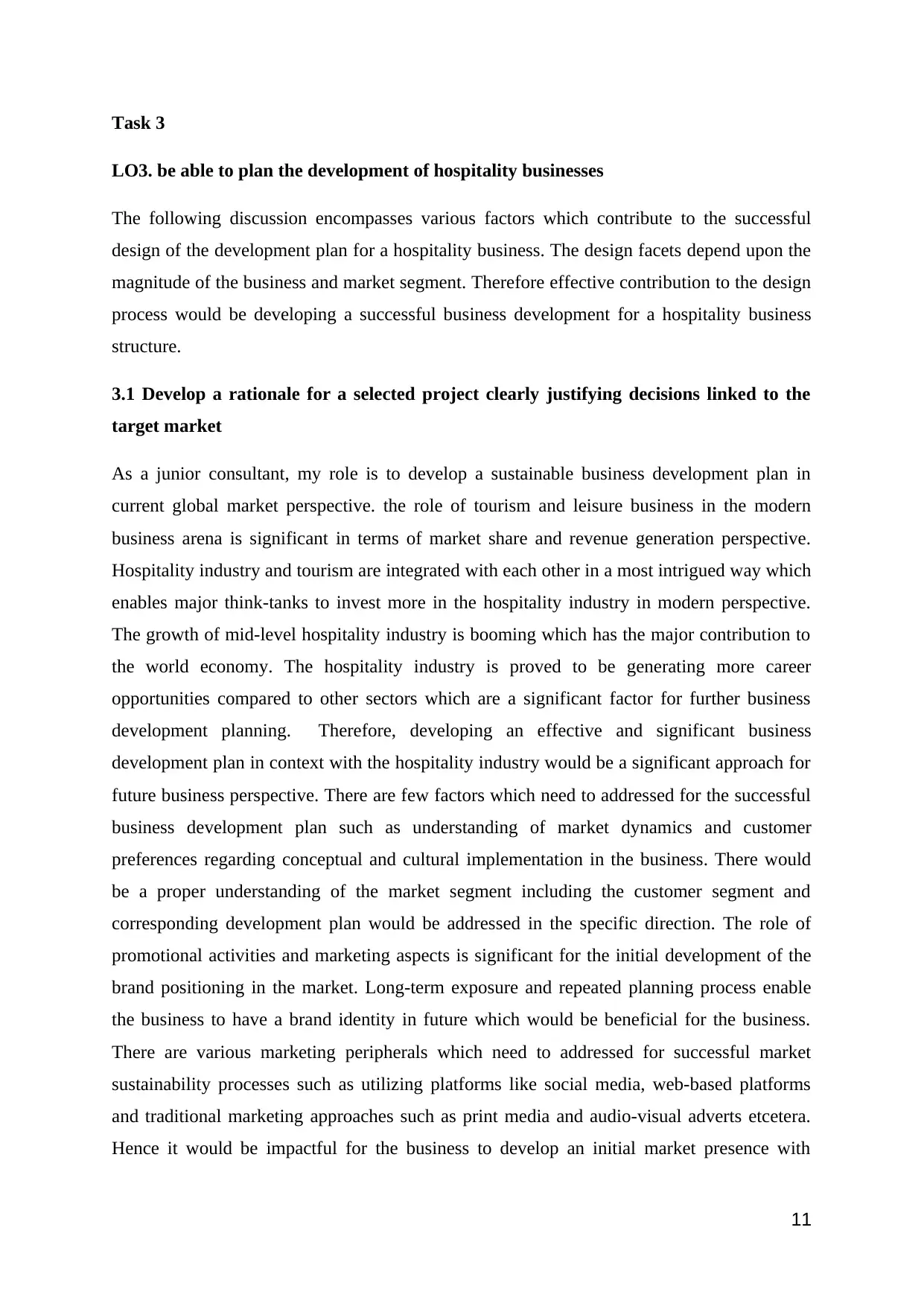
Task 3
LO3. be able to plan the development of hospitality businesses
The following discussion encompasses various factors which contribute to the successful
design of the development plan for a hospitality business. The design facets depend upon the
magnitude of the business and market segment. Therefore effective contribution to the design
process would be developing a successful business development for a hospitality business
structure.
3.1 Develop a rationale for a selected project clearly justifying decisions linked to the
target market
As a junior consultant, my role is to develop a sustainable business development plan in
current global market perspective. the role of tourism and leisure business in the modern
business arena is significant in terms of market share and revenue generation perspective.
Hospitality industry and tourism are integrated with each other in a most intrigued way which
enables major think-tanks to invest more in the hospitality industry in modern perspective.
The growth of mid-level hospitality industry is booming which has the major contribution to
the world economy. The hospitality industry is proved to be generating more career
opportunities compared to other sectors which are a significant factor for further business
development planning. Therefore, developing an effective and significant business
development plan in context with the hospitality industry would be a significant approach for
future business perspective. There are few factors which need to addressed for the successful
business development plan such as understanding of market dynamics and customer
preferences regarding conceptual and cultural implementation in the business. There would
be a proper understanding of the market segment including the customer segment and
corresponding development plan would be addressed in the specific direction. The role of
promotional activities and marketing aspects is significant for the initial development of the
brand positioning in the market. Long-term exposure and repeated planning process enable
the business to have a brand identity in future which would be beneficial for the business.
There are various marketing peripherals which need to addressed for successful market
sustainability processes such as utilizing platforms like social media, web-based platforms
and traditional marketing approaches such as print media and audio-visual adverts etcetera.
Hence it would be impactful for the business to develop an initial market presence with
11
LO3. be able to plan the development of hospitality businesses
The following discussion encompasses various factors which contribute to the successful
design of the development plan for a hospitality business. The design facets depend upon the
magnitude of the business and market segment. Therefore effective contribution to the design
process would be developing a successful business development for a hospitality business
structure.
3.1 Develop a rationale for a selected project clearly justifying decisions linked to the
target market
As a junior consultant, my role is to develop a sustainable business development plan in
current global market perspective. the role of tourism and leisure business in the modern
business arena is significant in terms of market share and revenue generation perspective.
Hospitality industry and tourism are integrated with each other in a most intrigued way which
enables major think-tanks to invest more in the hospitality industry in modern perspective.
The growth of mid-level hospitality industry is booming which has the major contribution to
the world economy. The hospitality industry is proved to be generating more career
opportunities compared to other sectors which are a significant factor for further business
development planning. Therefore, developing an effective and significant business
development plan in context with the hospitality industry would be a significant approach for
future business perspective. There are few factors which need to addressed for the successful
business development plan such as understanding of market dynamics and customer
preferences regarding conceptual and cultural implementation in the business. There would
be a proper understanding of the market segment including the customer segment and
corresponding development plan would be addressed in the specific direction. The role of
promotional activities and marketing aspects is significant for the initial development of the
brand positioning in the market. Long-term exposure and repeated planning process enable
the business to have a brand identity in future which would be beneficial for the business.
There are various marketing peripherals which need to addressed for successful market
sustainability processes such as utilizing platforms like social media, web-based platforms
and traditional marketing approaches such as print media and audio-visual adverts etcetera.
Hence it would be impactful for the business to develop an initial market presence with
11
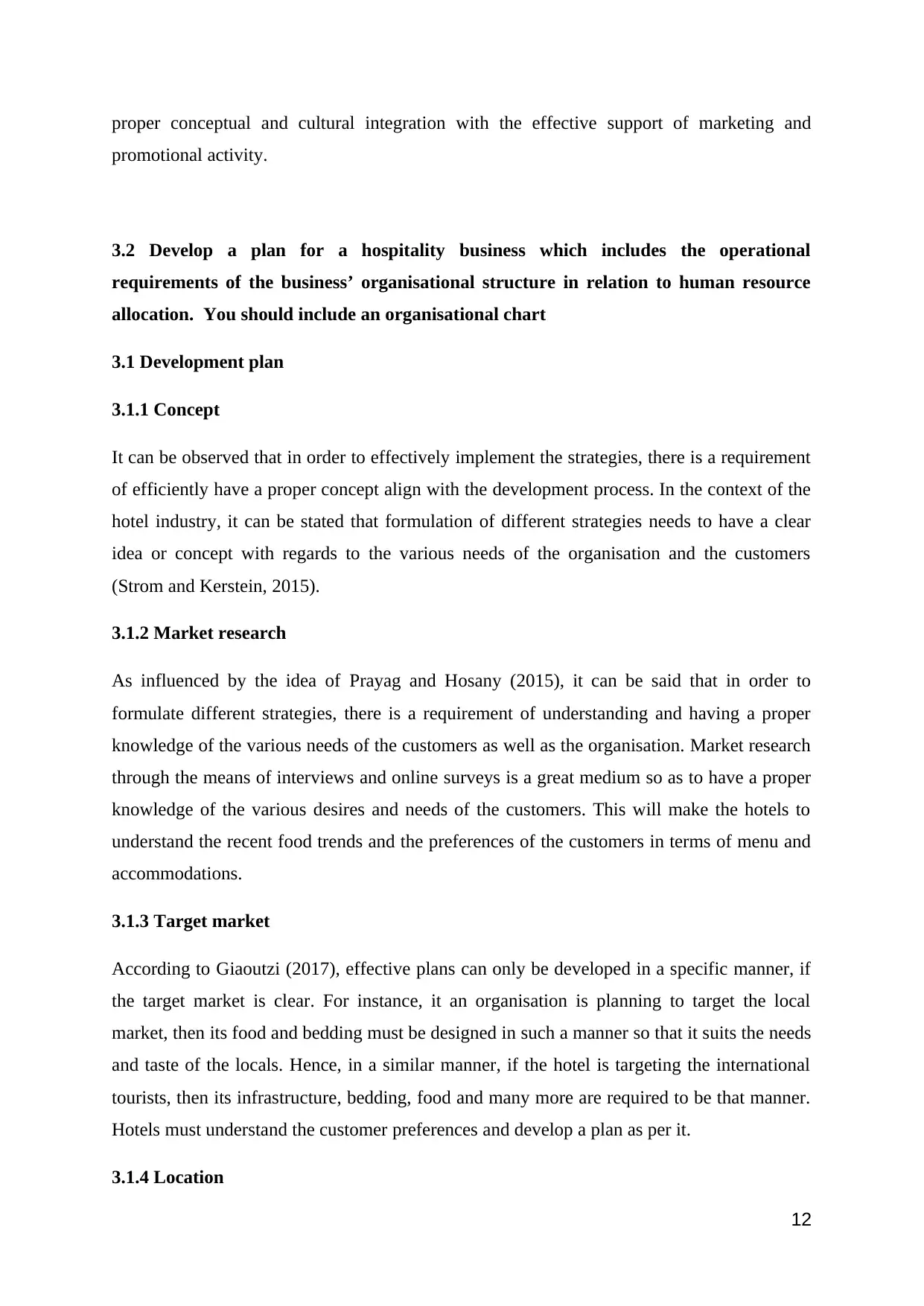
proper conceptual and cultural integration with the effective support of marketing and
promotional activity.
3.2 Develop a plan for a hospitality business which includes the operational
requirements of the business’ organisational structure in relation to human resource
allocation. You should include an organisational chart
3.1 Development plan
3.1.1 Concept
It can be observed that in order to effectively implement the strategies, there is a requirement
of efficiently have a proper concept align with the development process. In the context of the
hotel industry, it can be stated that formulation of different strategies needs to have a clear
idea or concept with regards to the various needs of the organisation and the customers
(Strom and Kerstein, 2015).
3.1.2 Market research
As influenced by the idea of Prayag and Hosany (2015), it can be said that in order to
formulate different strategies, there is a requirement of understanding and having a proper
knowledge of the various needs of the customers as well as the organisation. Market research
through the means of interviews and online surveys is a great medium so as to have a proper
knowledge of the various desires and needs of the customers. This will make the hotels to
understand the recent food trends and the preferences of the customers in terms of menu and
accommodations.
3.1.3 Target market
According to Giaoutzi (2017), effective plans can only be developed in a specific manner, if
the target market is clear. For instance, it an organisation is planning to target the local
market, then its food and bedding must be designed in such a manner so that it suits the needs
and taste of the locals. Hence, in a similar manner, if the hotel is targeting the international
tourists, then its infrastructure, bedding, food and many more are required to be that manner.
Hotels must understand the customer preferences and develop a plan as per it.
3.1.4 Location
12
promotional activity.
3.2 Develop a plan for a hospitality business which includes the operational
requirements of the business’ organisational structure in relation to human resource
allocation. You should include an organisational chart
3.1 Development plan
3.1.1 Concept
It can be observed that in order to effectively implement the strategies, there is a requirement
of efficiently have a proper concept align with the development process. In the context of the
hotel industry, it can be stated that formulation of different strategies needs to have a clear
idea or concept with regards to the various needs of the organisation and the customers
(Strom and Kerstein, 2015).
3.1.2 Market research
As influenced by the idea of Prayag and Hosany (2015), it can be said that in order to
formulate different strategies, there is a requirement of understanding and having a proper
knowledge of the various needs of the customers as well as the organisation. Market research
through the means of interviews and online surveys is a great medium so as to have a proper
knowledge of the various desires and needs of the customers. This will make the hotels to
understand the recent food trends and the preferences of the customers in terms of menu and
accommodations.
3.1.3 Target market
According to Giaoutzi (2017), effective plans can only be developed in a specific manner, if
the target market is clear. For instance, it an organisation is planning to target the local
market, then its food and bedding must be designed in such a manner so that it suits the needs
and taste of the locals. Hence, in a similar manner, if the hotel is targeting the international
tourists, then its infrastructure, bedding, food and many more are required to be that manner.
Hotels must understand the customer preferences and develop a plan as per it.
3.1.4 Location
12
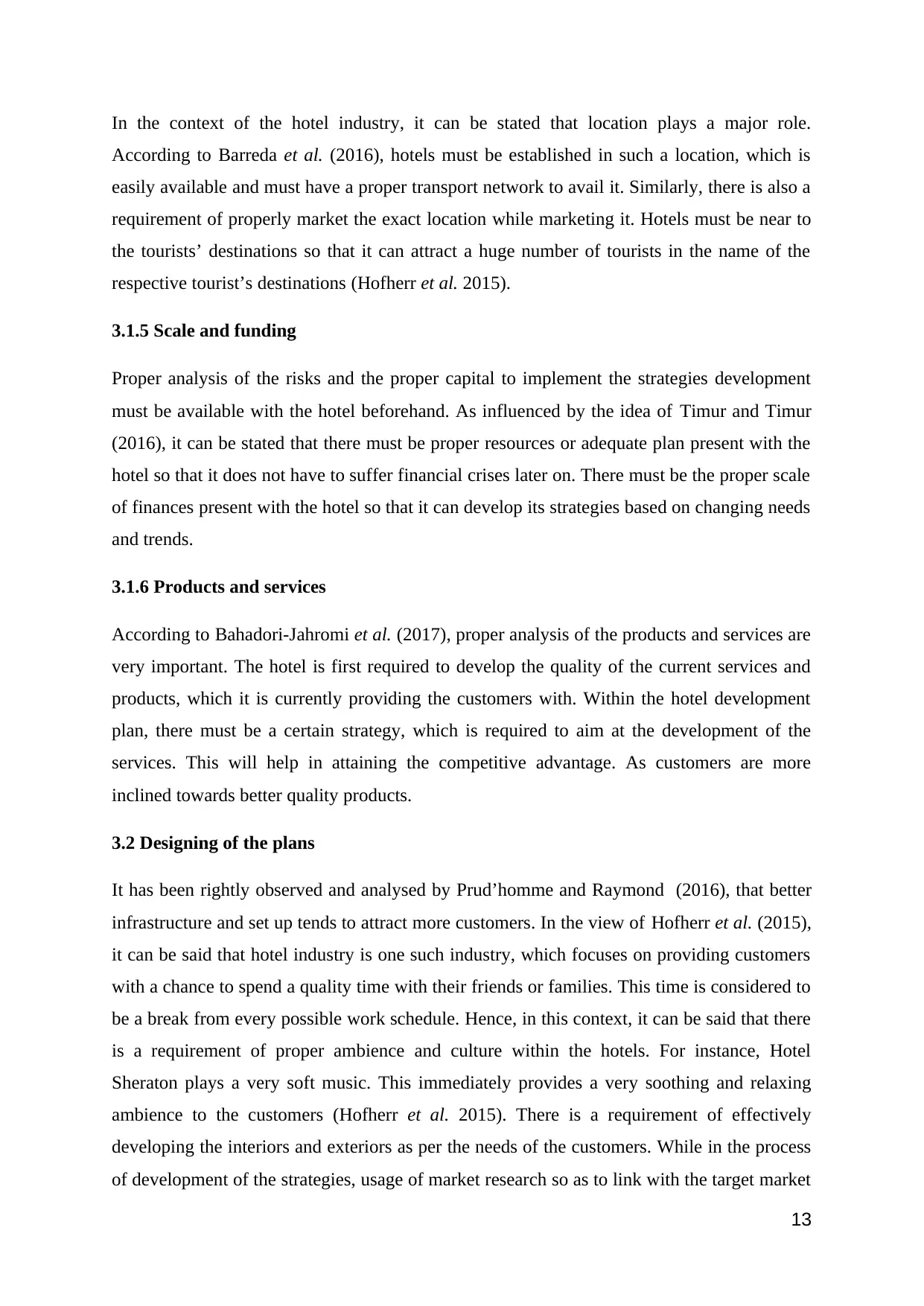
In the context of the hotel industry, it can be stated that location plays a major role.
According to Barreda et al. (2016), hotels must be established in such a location, which is
easily available and must have a proper transport network to avail it. Similarly, there is also a
requirement of properly market the exact location while marketing it. Hotels must be near to
the tourists’ destinations so that it can attract a huge number of tourists in the name of the
respective tourist’s destinations (Hofherr et al. 2015).
3.1.5 Scale and funding
Proper analysis of the risks and the proper capital to implement the strategies development
must be available with the hotel beforehand. As influenced by the idea of Timur and Timur
(2016), it can be stated that there must be proper resources or adequate plan present with the
hotel so that it does not have to suffer financial crises later on. There must be the proper scale
of finances present with the hotel so that it can develop its strategies based on changing needs
and trends.
3.1.6 Products and services
According to Bahadori-Jahromi et al. (2017), proper analysis of the products and services are
very important. The hotel is first required to develop the quality of the current services and
products, which it is currently providing the customers with. Within the hotel development
plan, there must be a certain strategy, which is required to aim at the development of the
services. This will help in attaining the competitive advantage. As customers are more
inclined towards better quality products.
3.2 Designing of the plans
It has been rightly observed and analysed by Prud’homme and Raymond (2016), that better
infrastructure and set up tends to attract more customers. In the view of Hofherr et al. (2015),
it can be said that hotel industry is one such industry, which focuses on providing customers
with a chance to spend a quality time with their friends or families. This time is considered to
be a break from every possible work schedule. Hence, in this context, it can be said that there
is a requirement of proper ambience and culture within the hotels. For instance, Hotel
Sheraton plays a very soft music. This immediately provides a very soothing and relaxing
ambience to the customers (Hofherr et al. 2015). There is a requirement of effectively
developing the interiors and exteriors as per the needs of the customers. While in the process
of development of the strategies, usage of market research so as to link with the target market
13
According to Barreda et al. (2016), hotels must be established in such a location, which is
easily available and must have a proper transport network to avail it. Similarly, there is also a
requirement of properly market the exact location while marketing it. Hotels must be near to
the tourists’ destinations so that it can attract a huge number of tourists in the name of the
respective tourist’s destinations (Hofherr et al. 2015).
3.1.5 Scale and funding
Proper analysis of the risks and the proper capital to implement the strategies development
must be available with the hotel beforehand. As influenced by the idea of Timur and Timur
(2016), it can be stated that there must be proper resources or adequate plan present with the
hotel so that it does not have to suffer financial crises later on. There must be the proper scale
of finances present with the hotel so that it can develop its strategies based on changing needs
and trends.
3.1.6 Products and services
According to Bahadori-Jahromi et al. (2017), proper analysis of the products and services are
very important. The hotel is first required to develop the quality of the current services and
products, which it is currently providing the customers with. Within the hotel development
plan, there must be a certain strategy, which is required to aim at the development of the
services. This will help in attaining the competitive advantage. As customers are more
inclined towards better quality products.
3.2 Designing of the plans
It has been rightly observed and analysed by Prud’homme and Raymond (2016), that better
infrastructure and set up tends to attract more customers. In the view of Hofherr et al. (2015),
it can be said that hotel industry is one such industry, which focuses on providing customers
with a chance to spend a quality time with their friends or families. This time is considered to
be a break from every possible work schedule. Hence, in this context, it can be said that there
is a requirement of proper ambience and culture within the hotels. For instance, Hotel
Sheraton plays a very soft music. This immediately provides a very soothing and relaxing
ambience to the customers (Hofherr et al. 2015). There is a requirement of effectively
developing the interiors and exteriors as per the needs of the customers. While in the process
of development of the strategies, usage of market research so as to link with the target market
13
Paraphrase This Document
Need a fresh take? Get an instant paraphrase of this document with our AI Paraphraser
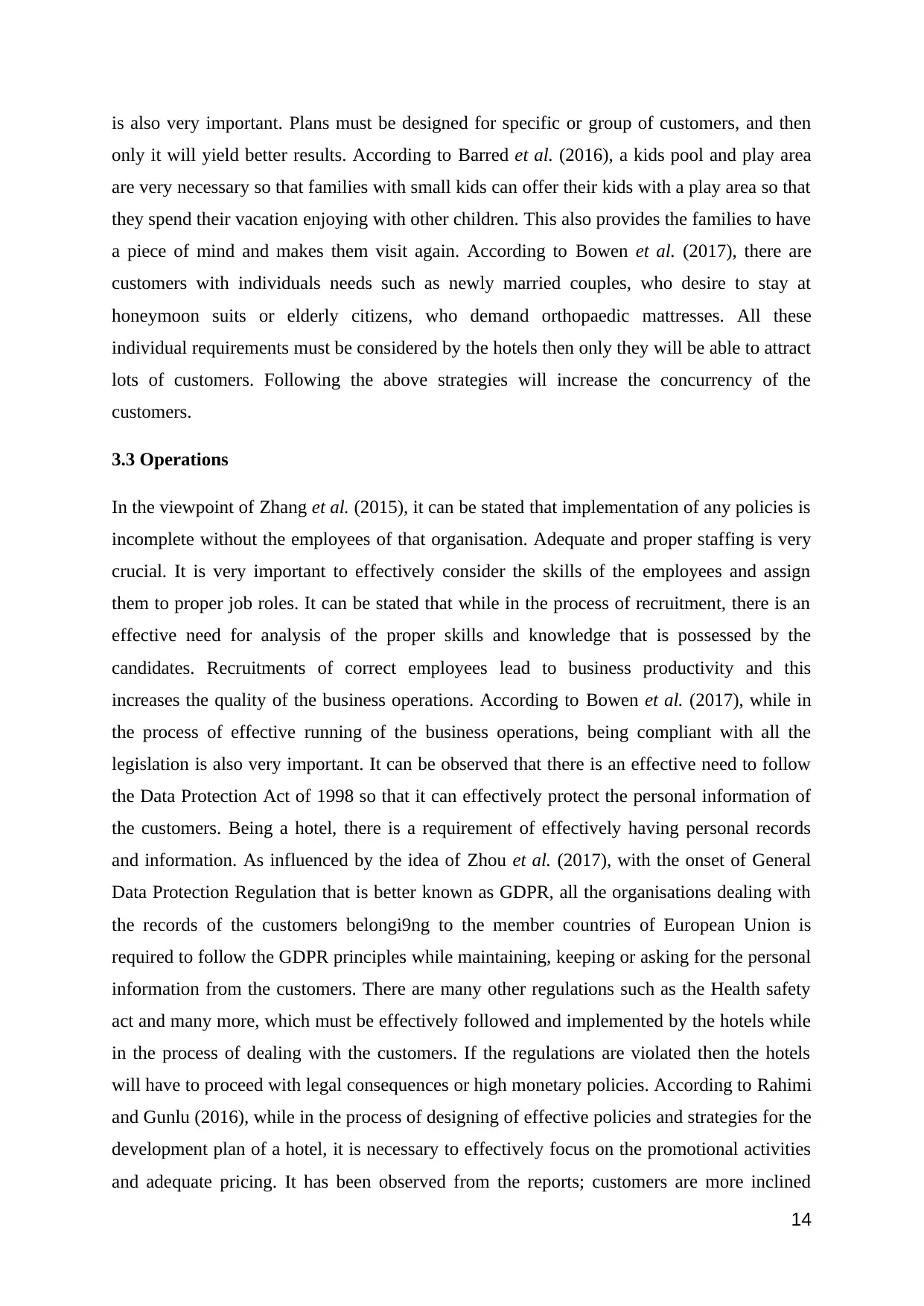
is also very important. Plans must be designed for specific or group of customers, and then
only it will yield better results. According to Barred et al. (2016), a kids pool and play area
are very necessary so that families with small kids can offer their kids with a play area so that
they spend their vacation enjoying with other children. This also provides the families to have
a piece of mind and makes them visit again. According to Bowen et al. (2017), there are
customers with individuals needs such as newly married couples, who desire to stay at
honeymoon suits or elderly citizens, who demand orthopaedic mattresses. All these
individual requirements must be considered by the hotels then only they will be able to attract
lots of customers. Following the above strategies will increase the concurrency of the
customers.
3.3 Operations
In the viewpoint of Zhang et al. (2015), it can be stated that implementation of any policies is
incomplete without the employees of that organisation. Adequate and proper staffing is very
crucial. It is very important to effectively consider the skills of the employees and assign
them to proper job roles. It can be stated that while in the process of recruitment, there is an
effective need for analysis of the proper skills and knowledge that is possessed by the
candidates. Recruitments of correct employees lead to business productivity and this
increases the quality of the business operations. According to Bowen et al. (2017), while in
the process of effective running of the business operations, being compliant with all the
legislation is also very important. It can be observed that there is an effective need to follow
the Data Protection Act of 1998 so that it can effectively protect the personal information of
the customers. Being a hotel, there is a requirement of effectively having personal records
and information. As influenced by the idea of Zhou et al. (2017), with the onset of General
Data Protection Regulation that is better known as GDPR, all the organisations dealing with
the records of the customers belongi9ng to the member countries of European Union is
required to follow the GDPR principles while maintaining, keeping or asking for the personal
information from the customers. There are many other regulations such as the Health safety
act and many more, which must be effectively followed and implemented by the hotels while
in the process of dealing with the customers. If the regulations are violated then the hotels
will have to proceed with legal consequences or high monetary policies. According to Rahimi
and Gunlu (2016), while in the process of designing of effective policies and strategies for the
development plan of a hotel, it is necessary to effectively focus on the promotional activities
and adequate pricing. It has been observed from the reports; customers are more inclined
14
only it will yield better results. According to Barred et al. (2016), a kids pool and play area
are very necessary so that families with small kids can offer their kids with a play area so that
they spend their vacation enjoying with other children. This also provides the families to have
a piece of mind and makes them visit again. According to Bowen et al. (2017), there are
customers with individuals needs such as newly married couples, who desire to stay at
honeymoon suits or elderly citizens, who demand orthopaedic mattresses. All these
individual requirements must be considered by the hotels then only they will be able to attract
lots of customers. Following the above strategies will increase the concurrency of the
customers.
3.3 Operations
In the viewpoint of Zhang et al. (2015), it can be stated that implementation of any policies is
incomplete without the employees of that organisation. Adequate and proper staffing is very
crucial. It is very important to effectively consider the skills of the employees and assign
them to proper job roles. It can be stated that while in the process of recruitment, there is an
effective need for analysis of the proper skills and knowledge that is possessed by the
candidates. Recruitments of correct employees lead to business productivity and this
increases the quality of the business operations. According to Bowen et al. (2017), while in
the process of effective running of the business operations, being compliant with all the
legislation is also very important. It can be observed that there is an effective need to follow
the Data Protection Act of 1998 so that it can effectively protect the personal information of
the customers. Being a hotel, there is a requirement of effectively having personal records
and information. As influenced by the idea of Zhou et al. (2017), with the onset of General
Data Protection Regulation that is better known as GDPR, all the organisations dealing with
the records of the customers belongi9ng to the member countries of European Union is
required to follow the GDPR principles while maintaining, keeping or asking for the personal
information from the customers. There are many other regulations such as the Health safety
act and many more, which must be effectively followed and implemented by the hotels while
in the process of dealing with the customers. If the regulations are violated then the hotels
will have to proceed with legal consequences or high monetary policies. According to Rahimi
and Gunlu (2016), while in the process of designing of effective policies and strategies for the
development plan of a hotel, it is necessary to effectively focus on the promotional activities
and adequate pricing. It has been observed from the reports; customers are more inclined
14

towards offers and discounts. Hotels can effectively advertise the brand over social media,
which will create an effective platform so that customers can be effectively interacted with.
Organisation Chart:
A mid-sized hotel contributes to the major section of the revenue generation in the hospitality
industry which consist of director or board which controls and creates policies for the growth
and development of the hotel. The functionality of the hotel monitored and controlled by the
senior housekeeper staff that is accountable to the functionality internal processes in the
hotel. The assistant housekeeper effectively manages various departments such as sales,
marketing, accounts and support staff which contributes to the effective functioning of the
hotel.
15
which will create an effective platform so that customers can be effectively interacted with.
Organisation Chart:
A mid-sized hotel contributes to the major section of the revenue generation in the hospitality
industry which consist of director or board which controls and creates policies for the growth
and development of the hotel. The functionality of the hotel monitored and controlled by the
senior housekeeper staff that is accountable to the functionality internal processes in the
hotel. The assistant housekeeper effectively manages various departments such as sales,
marketing, accounts and support staff which contributes to the effective functioning of the
hotel.
15

Conclusion:
It could be concluded from the above discussion that the contribution of the tourism section
in the hospitality industry is undeniable. The major industrial boom regarding hospitality
industry attributed the overall economic growth of the regions which are majorly associated
with the tourism sector. There are various significant mergers has been taken place in the
hospitality industry arena which has a major impact on the overall industrial development and
growth. Therefore it would be strategically appropriate time to develop a business plan in
context with mid-level hospitality industry aspect. Therefore the hospitality industry
irrespective of the magnitude attributed successfully to the tourism industry which enables
both the industries to grow and develop significantly in modern market and business
perspective.
16
It could be concluded from the above discussion that the contribution of the tourism section
in the hospitality industry is undeniable. The major industrial boom regarding hospitality
industry attributed the overall economic growth of the regions which are majorly associated
with the tourism sector. There are various significant mergers has been taken place in the
hospitality industry arena which has a major impact on the overall industrial development and
growth. Therefore it would be strategically appropriate time to develop a business plan in
context with mid-level hospitality industry aspect. Therefore the hospitality industry
irrespective of the magnitude attributed successfully to the tourism industry which enables
both the industries to grow and develop significantly in modern market and business
perspective.
16
Secure Best Marks with AI Grader
Need help grading? Try our AI Grader for instant feedback on your assignments.

References:
Bahadori-Jahromi, A., Rotimi, A., Mylona, A., Godfrey, P. and Cook, D., 2017.
Impact of window films on the overall energy consumption of existing UK hotel
buildings. Sustainability, 9(5), p.731.
Barreda, A.A., Bilgihan, A., Nusair, K. and Okumus, F., 2016. Online branding:
Development of hotel branding through interactivity theory. Tourism
Management, 57, pp.180-192.
Berné, C., García-González, M., García-Uceda, M.E. and Múgica, J.M., 2015. The
effect of ICT on relationship enhancement and performance in tourism
channels. Tourism Management, 48, pp.188-198.
Bowen, D., Zubair, S. and Altinay, L., 2017. Politics and Tourism Destination
Development: The Evolution of Power. Journal of Travel Research, 56(6), pp.725-
743.
Chen, K.Y., 2014. Improving importance-performance analysis: The role of the zone
of tolerance and competitor performance. The case of Taiwan's hot spring
hotels. Tourism Management, 40, pp.260-272.
dos Santos, R.A., Méxas, M.P. and Meiriño, M.J., 2017. Sustainability and hotel
business: criteria for holistic, integrated and participative development. Journal of
cleaner production, 142, pp.217-224.
Giaoutzi, M., 2017. Tourism and regional development: New pathways. Routledge.
Hofherr, J., Natale, F. and Trujillo, P., 2015. Is lack of space a limiting factor for the
development of aquaculture in EU coastal areas?. Ocean & Coastal
Management, 116, pp.27-36.
Lee, S.K., 2015. Quality differentiation and conditional spatial price competition
among hotels. Tourism Management, 46, pp.114-122.
Lind, H., 2015. Vertical integration in the real estate sector: Three case studies (No.
15/7).
Neirotti, P., Raguseo, E. and Paolucci, E., 2016. Are customers’ reviews creating
value in the hospitality industry? Exploring the moderating effects of market
positioning. International Journal of Information Management, 36(6), pp.1133-1143.
Porcu, L., Del Barrio-García, S. and Kitchen, P.J., 2017. Measuring integrated
marketing communication by taking a broad organisational approach: The firm-wide
IMC scale. European Journal of Marketing, 51(3), pp.692-718.
17
Bahadori-Jahromi, A., Rotimi, A., Mylona, A., Godfrey, P. and Cook, D., 2017.
Impact of window films on the overall energy consumption of existing UK hotel
buildings. Sustainability, 9(5), p.731.
Barreda, A.A., Bilgihan, A., Nusair, K. and Okumus, F., 2016. Online branding:
Development of hotel branding through interactivity theory. Tourism
Management, 57, pp.180-192.
Berné, C., García-González, M., García-Uceda, M.E. and Múgica, J.M., 2015. The
effect of ICT on relationship enhancement and performance in tourism
channels. Tourism Management, 48, pp.188-198.
Bowen, D., Zubair, S. and Altinay, L., 2017. Politics and Tourism Destination
Development: The Evolution of Power. Journal of Travel Research, 56(6), pp.725-
743.
Chen, K.Y., 2014. Improving importance-performance analysis: The role of the zone
of tolerance and competitor performance. The case of Taiwan's hot spring
hotels. Tourism Management, 40, pp.260-272.
dos Santos, R.A., Méxas, M.P. and Meiriño, M.J., 2017. Sustainability and hotel
business: criteria for holistic, integrated and participative development. Journal of
cleaner production, 142, pp.217-224.
Giaoutzi, M., 2017. Tourism and regional development: New pathways. Routledge.
Hofherr, J., Natale, F. and Trujillo, P., 2015. Is lack of space a limiting factor for the
development of aquaculture in EU coastal areas?. Ocean & Coastal
Management, 116, pp.27-36.
Lee, S.K., 2015. Quality differentiation and conditional spatial price competition
among hotels. Tourism Management, 46, pp.114-122.
Lind, H., 2015. Vertical integration in the real estate sector: Three case studies (No.
15/7).
Neirotti, P., Raguseo, E. and Paolucci, E., 2016. Are customers’ reviews creating
value in the hospitality industry? Exploring the moderating effects of market
positioning. International Journal of Information Management, 36(6), pp.1133-1143.
Porcu, L., Del Barrio-García, S. and Kitchen, P.J., 2017. Measuring integrated
marketing communication by taking a broad organisational approach: The firm-wide
IMC scale. European Journal of Marketing, 51(3), pp.692-718.
17
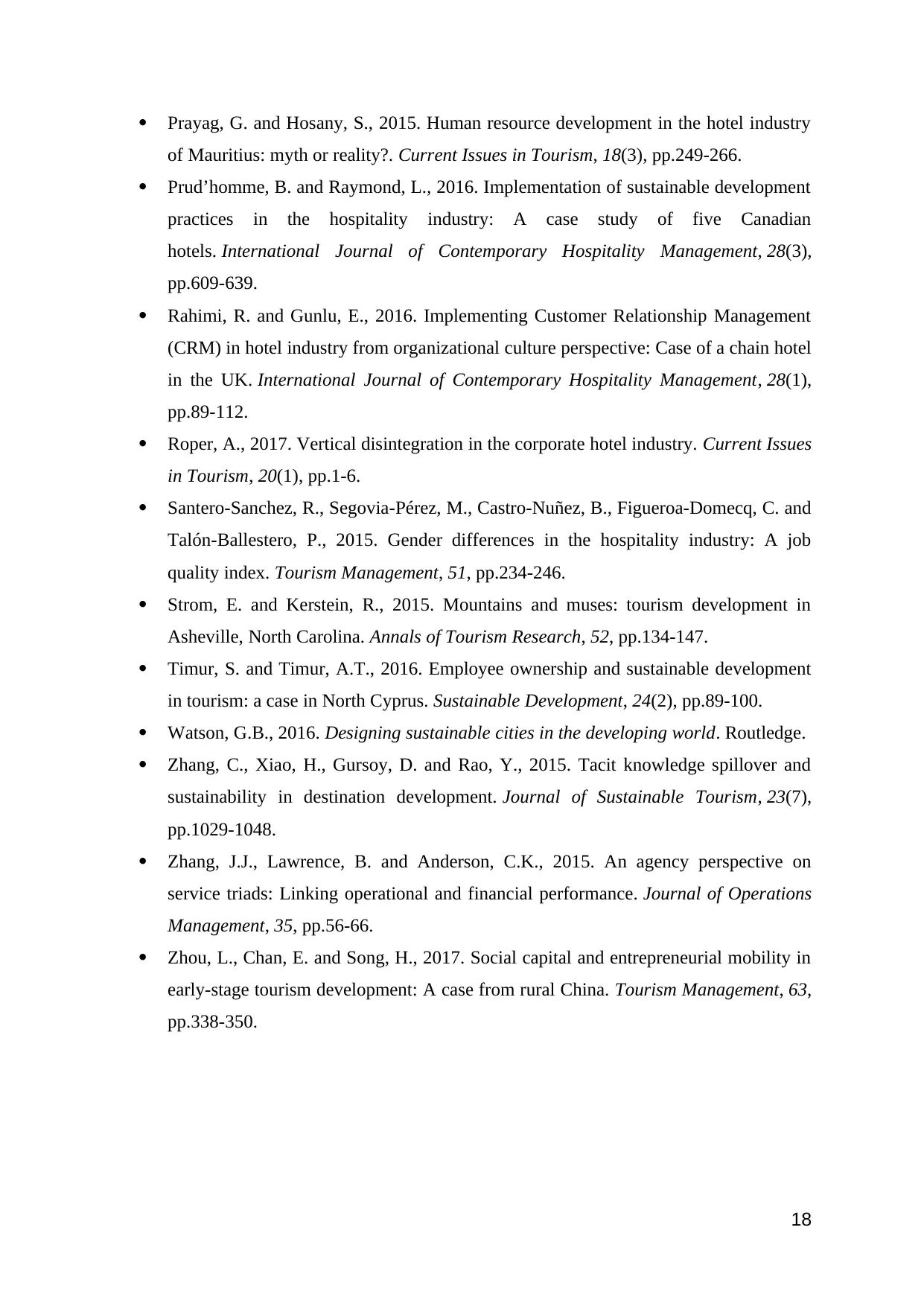
Prayag, G. and Hosany, S., 2015. Human resource development in the hotel industry
of Mauritius: myth or reality?. Current Issues in Tourism, 18(3), pp.249-266.
Prud’homme, B. and Raymond, L., 2016. Implementation of sustainable development
practices in the hospitality industry: A case study of five Canadian
hotels. International Journal of Contemporary Hospitality Management, 28(3),
pp.609-639.
Rahimi, R. and Gunlu, E., 2016. Implementing Customer Relationship Management
(CRM) in hotel industry from organizational culture perspective: Case of a chain hotel
in the UK. International Journal of Contemporary Hospitality Management, 28(1),
pp.89-112.
Roper, A., 2017. Vertical disintegration in the corporate hotel industry. Current Issues
in Tourism, 20(1), pp.1-6.
Santero-Sanchez, R., Segovia-Pérez, M., Castro-Nuñez, B., Figueroa-Domecq, C. and
Talón-Ballestero, P., 2015. Gender differences in the hospitality industry: A job
quality index. Tourism Management, 51, pp.234-246.
Strom, E. and Kerstein, R., 2015. Mountains and muses: tourism development in
Asheville, North Carolina. Annals of Tourism Research, 52, pp.134-147.
Timur, S. and Timur, A.T., 2016. Employee ownership and sustainable development
in tourism: a case in North Cyprus. Sustainable Development, 24(2), pp.89-100.
Watson, G.B., 2016. Designing sustainable cities in the developing world. Routledge.
Zhang, C., Xiao, H., Gursoy, D. and Rao, Y., 2015. Tacit knowledge spillover and
sustainability in destination development. Journal of Sustainable Tourism, 23(7),
pp.1029-1048.
Zhang, J.J., Lawrence, B. and Anderson, C.K., 2015. An agency perspective on
service triads: Linking operational and financial performance. Journal of Operations
Management, 35, pp.56-66.
Zhou, L., Chan, E. and Song, H., 2017. Social capital and entrepreneurial mobility in
early-stage tourism development: A case from rural China. Tourism Management, 63,
pp.338-350.
18
of Mauritius: myth or reality?. Current Issues in Tourism, 18(3), pp.249-266.
Prud’homme, B. and Raymond, L., 2016. Implementation of sustainable development
practices in the hospitality industry: A case study of five Canadian
hotels. International Journal of Contemporary Hospitality Management, 28(3),
pp.609-639.
Rahimi, R. and Gunlu, E., 2016. Implementing Customer Relationship Management
(CRM) in hotel industry from organizational culture perspective: Case of a chain hotel
in the UK. International Journal of Contemporary Hospitality Management, 28(1),
pp.89-112.
Roper, A., 2017. Vertical disintegration in the corporate hotel industry. Current Issues
in Tourism, 20(1), pp.1-6.
Santero-Sanchez, R., Segovia-Pérez, M., Castro-Nuñez, B., Figueroa-Domecq, C. and
Talón-Ballestero, P., 2015. Gender differences in the hospitality industry: A job
quality index. Tourism Management, 51, pp.234-246.
Strom, E. and Kerstein, R., 2015. Mountains and muses: tourism development in
Asheville, North Carolina. Annals of Tourism Research, 52, pp.134-147.
Timur, S. and Timur, A.T., 2016. Employee ownership and sustainable development
in tourism: a case in North Cyprus. Sustainable Development, 24(2), pp.89-100.
Watson, G.B., 2016. Designing sustainable cities in the developing world. Routledge.
Zhang, C., Xiao, H., Gursoy, D. and Rao, Y., 2015. Tacit knowledge spillover and
sustainability in destination development. Journal of Sustainable Tourism, 23(7),
pp.1029-1048.
Zhang, J.J., Lawrence, B. and Anderson, C.K., 2015. An agency perspective on
service triads: Linking operational and financial performance. Journal of Operations
Management, 35, pp.56-66.
Zhou, L., Chan, E. and Song, H., 2017. Social capital and entrepreneurial mobility in
early-stage tourism development: A case from rural China. Tourism Management, 63,
pp.338-350.
18

19
1 out of 19
Related Documents
Your All-in-One AI-Powered Toolkit for Academic Success.
+13062052269
info@desklib.com
Available 24*7 on WhatsApp / Email
![[object Object]](/_next/static/media/star-bottom.7253800d.svg)
Unlock your academic potential
© 2024 | Zucol Services PVT LTD | All rights reserved.





